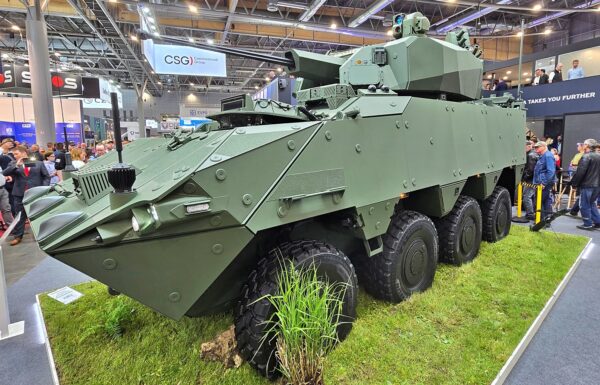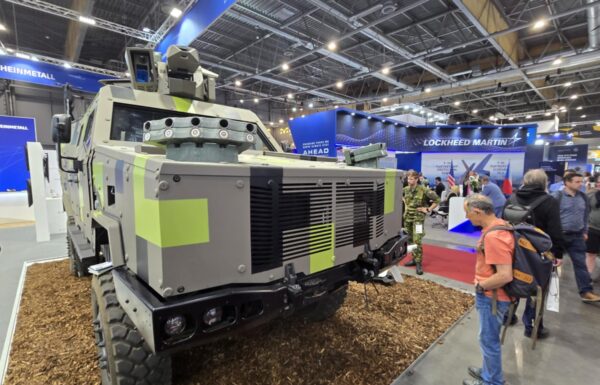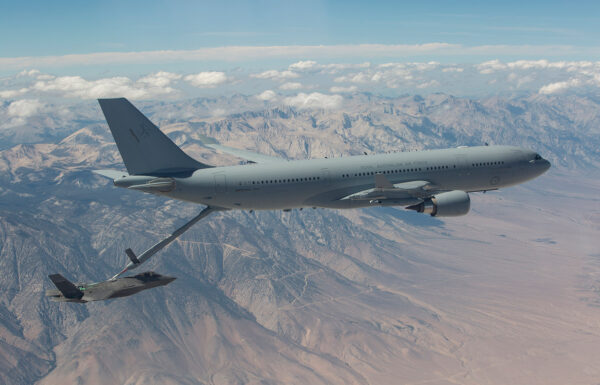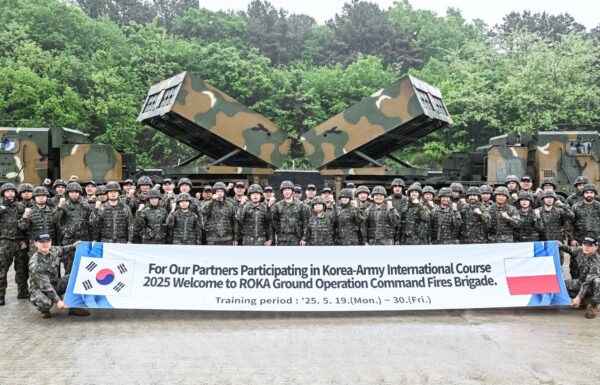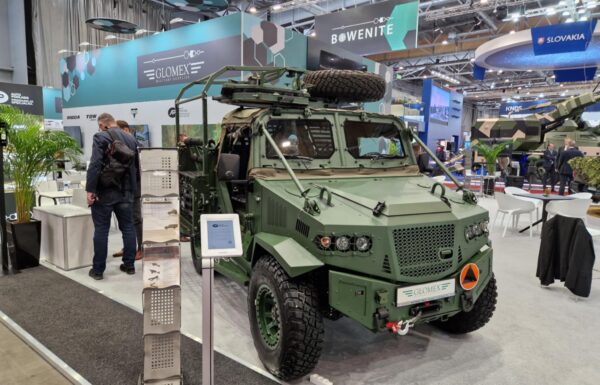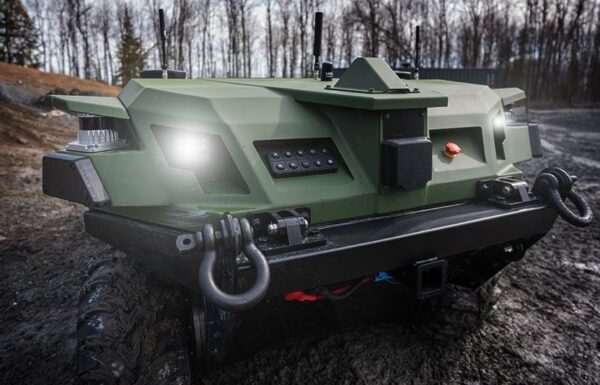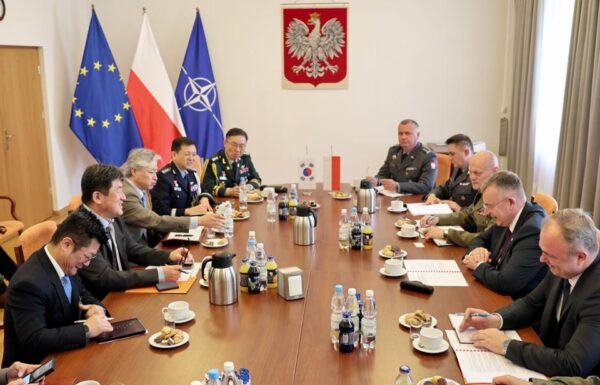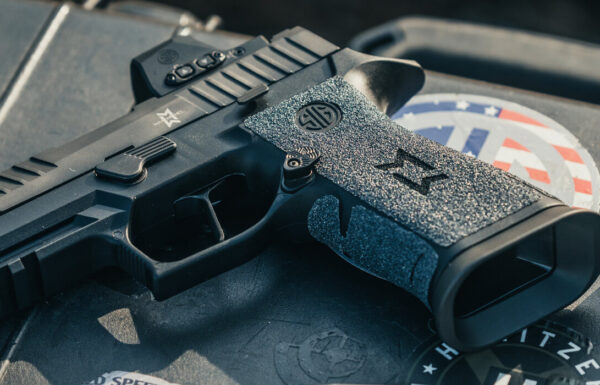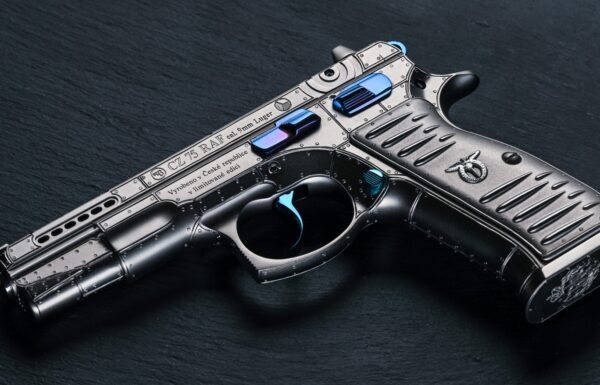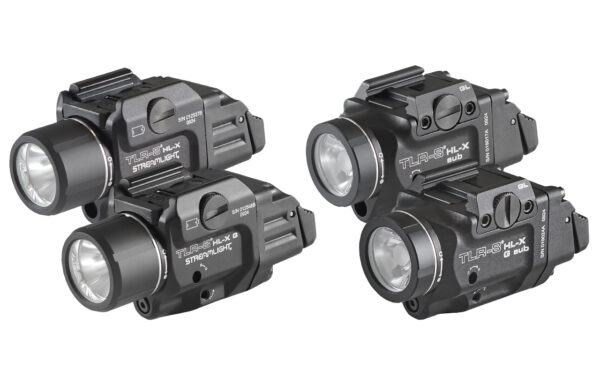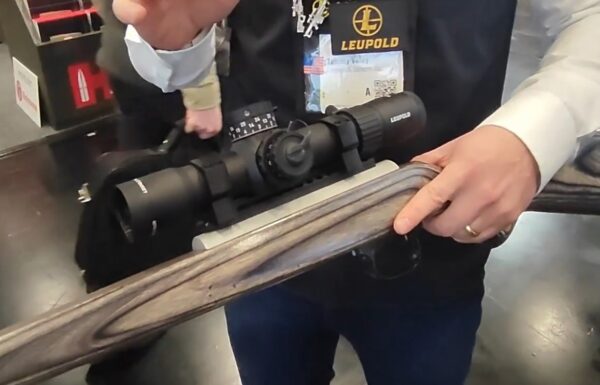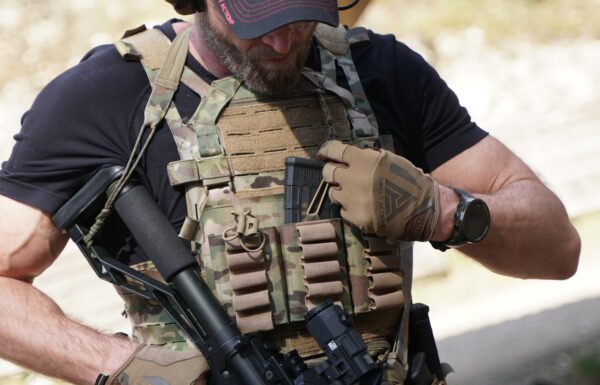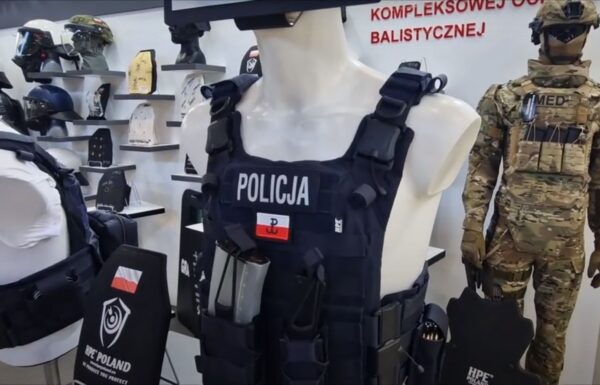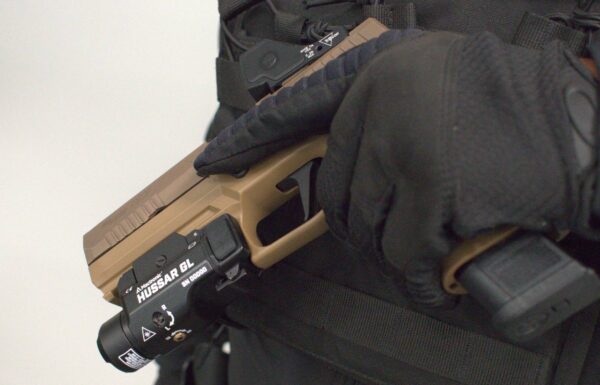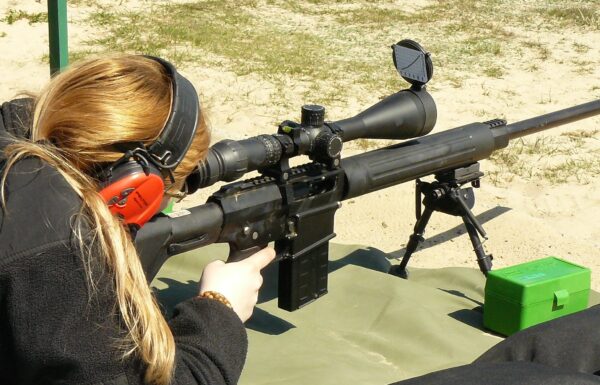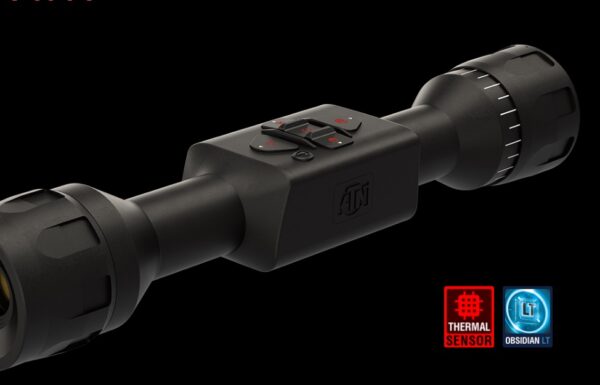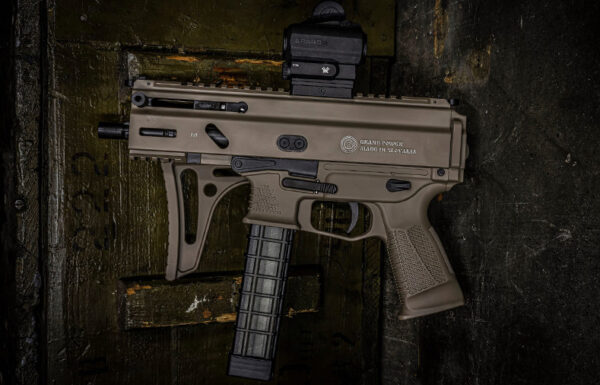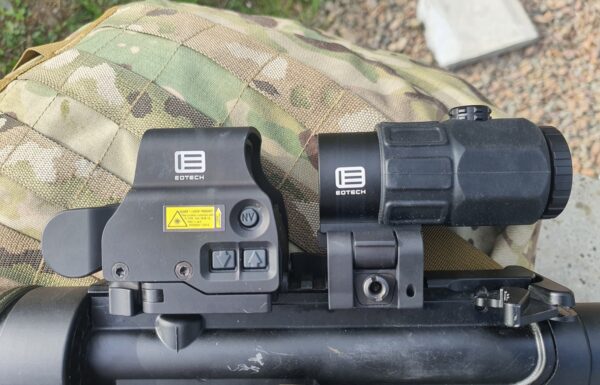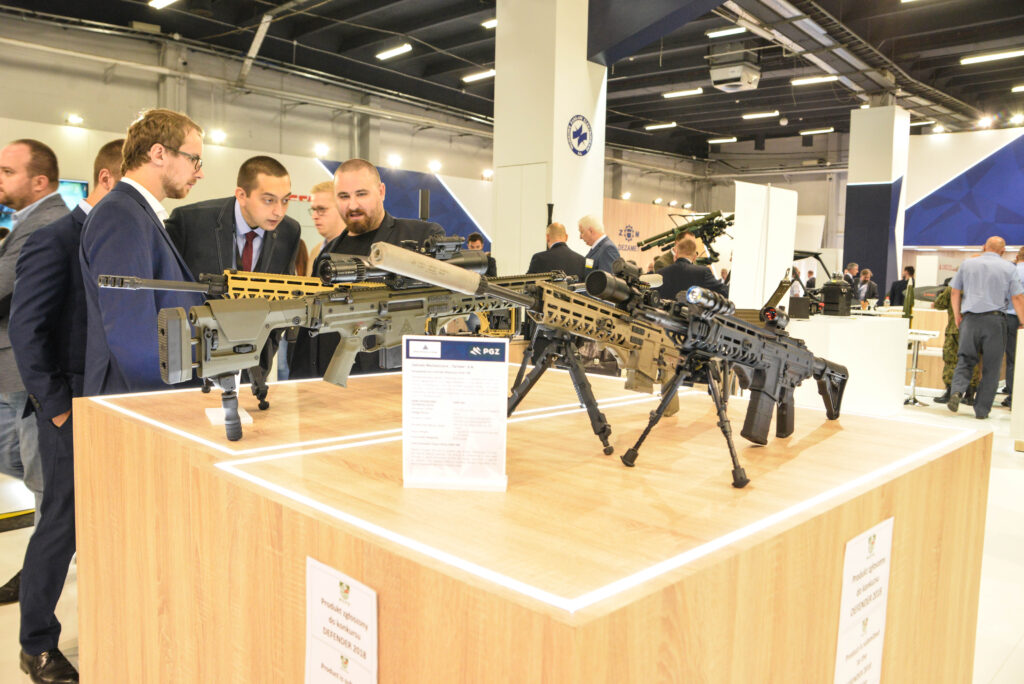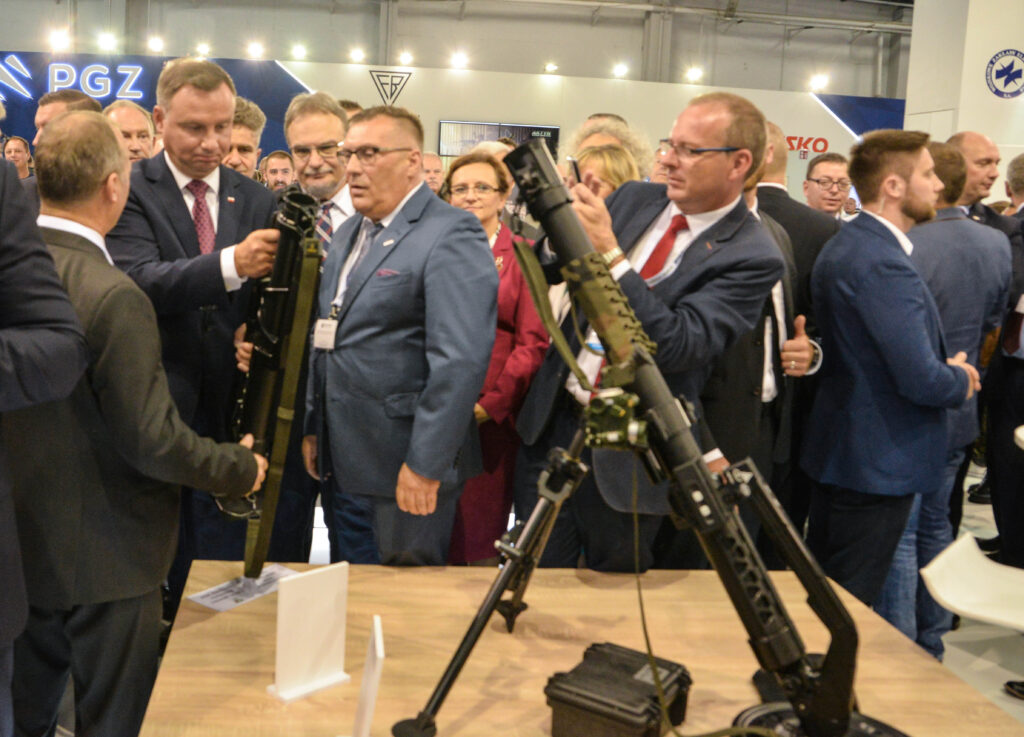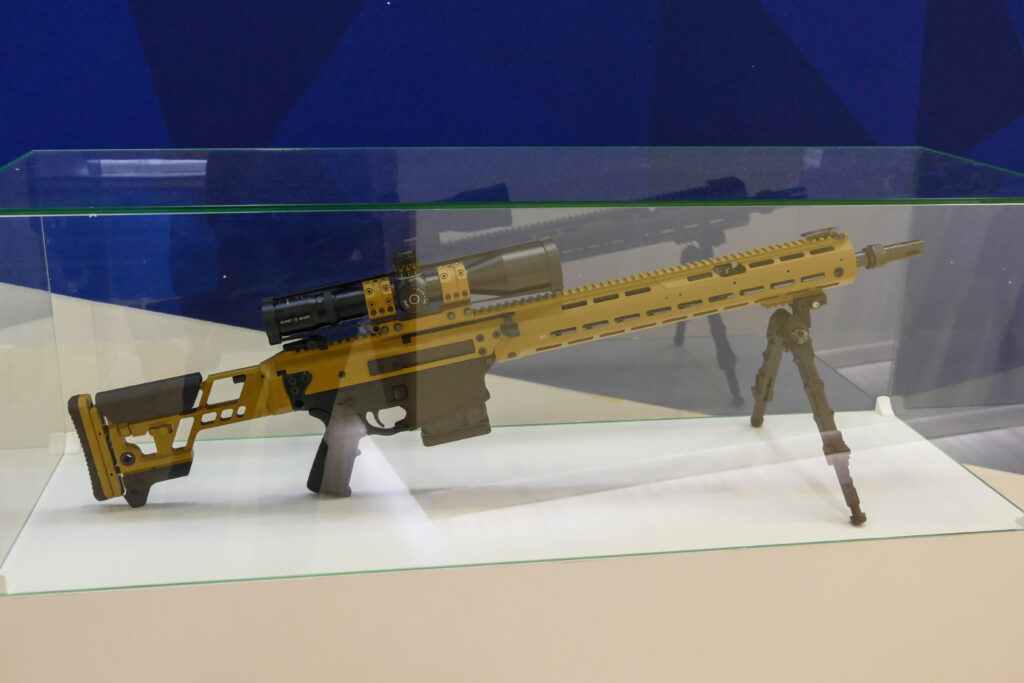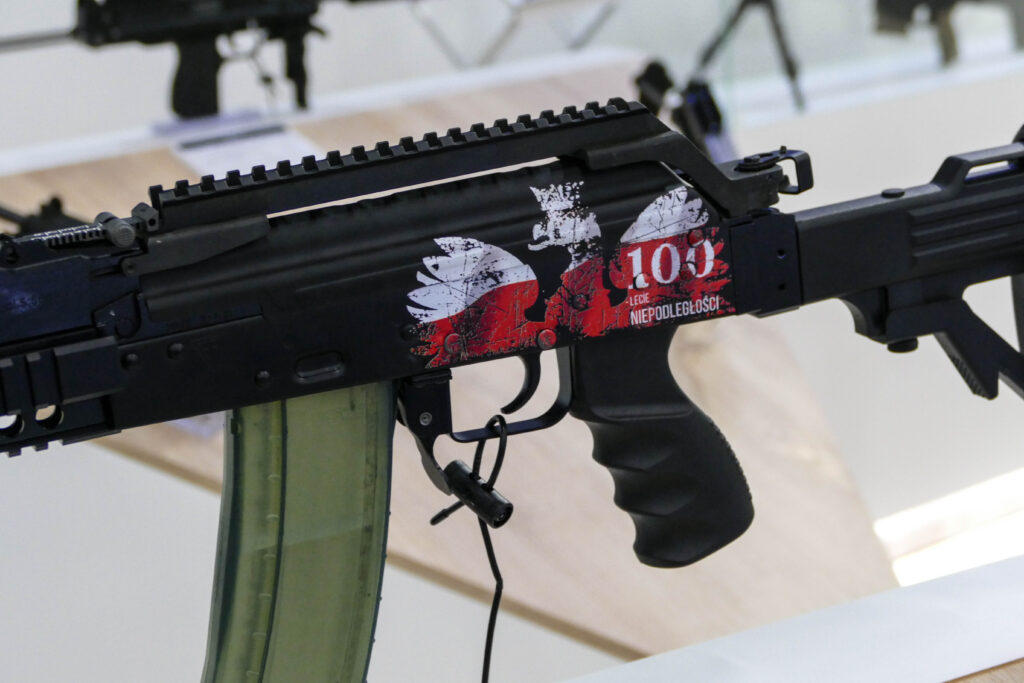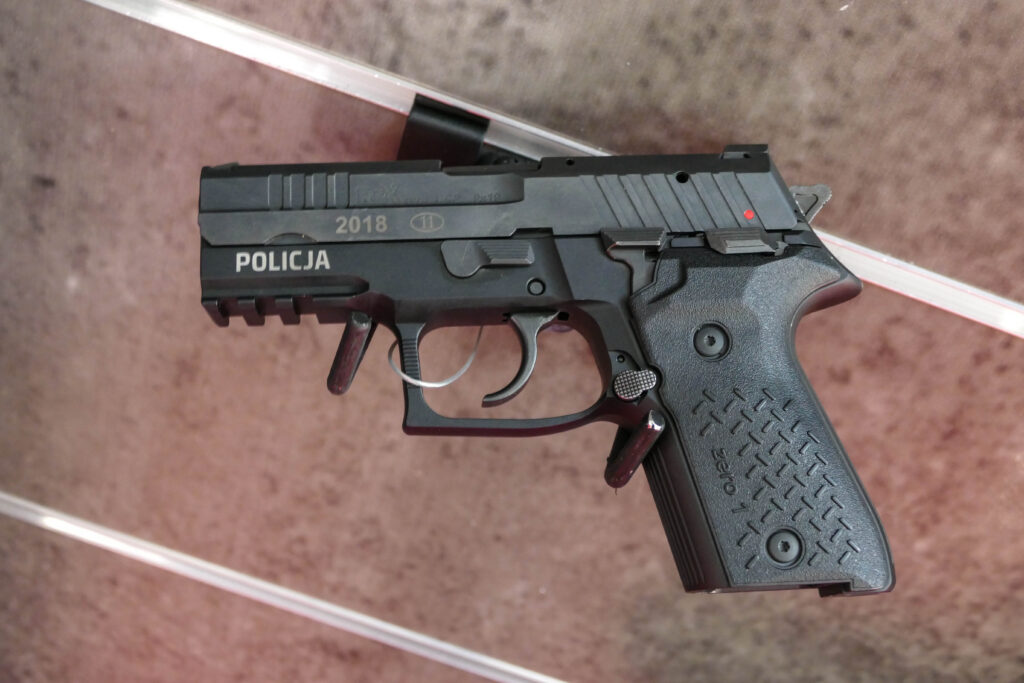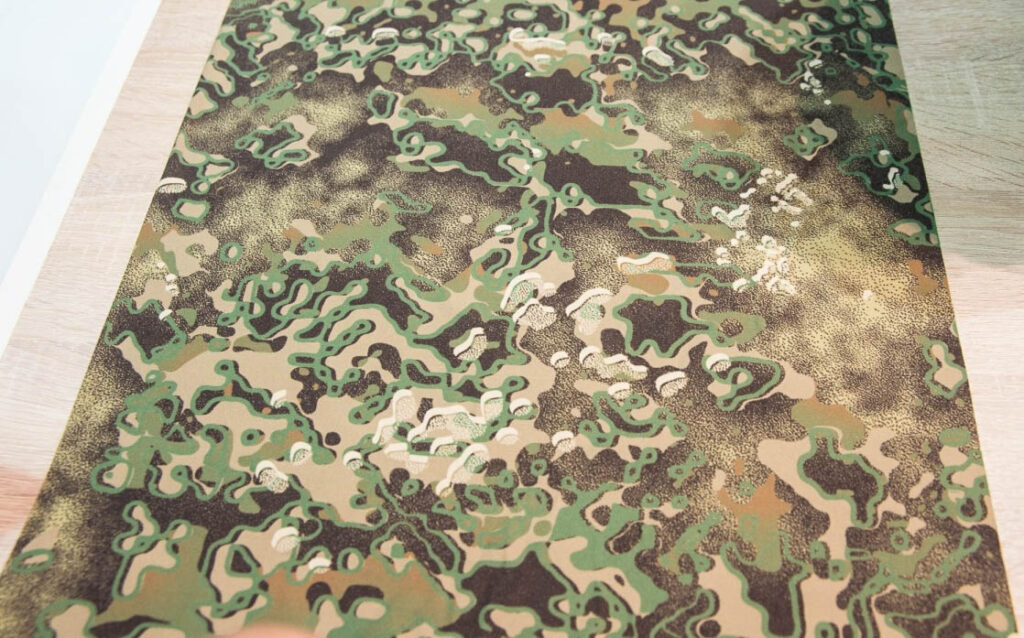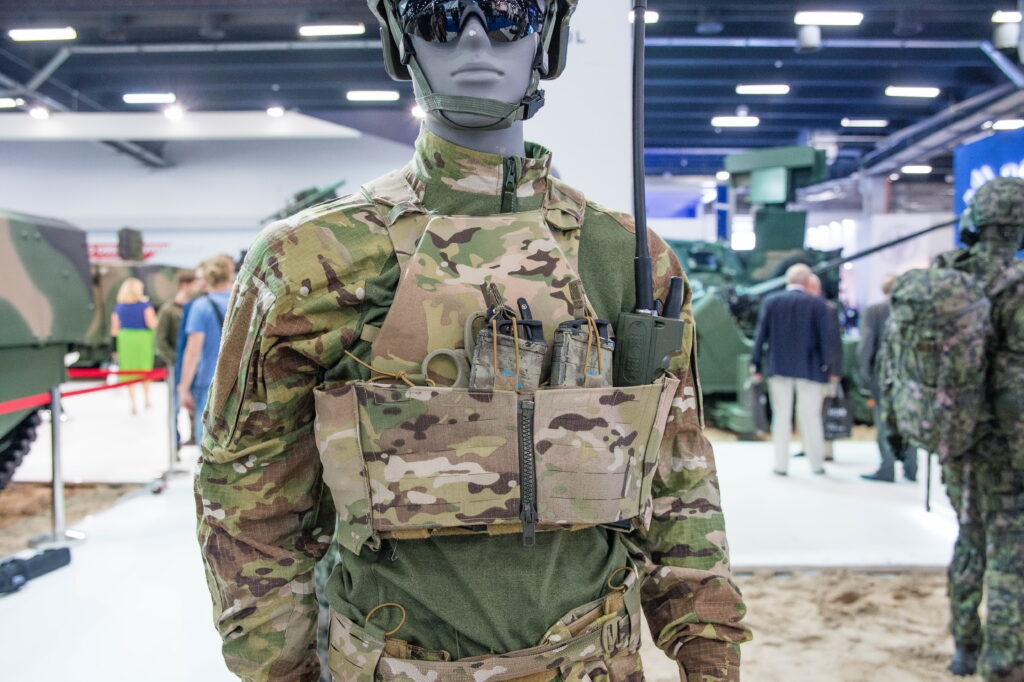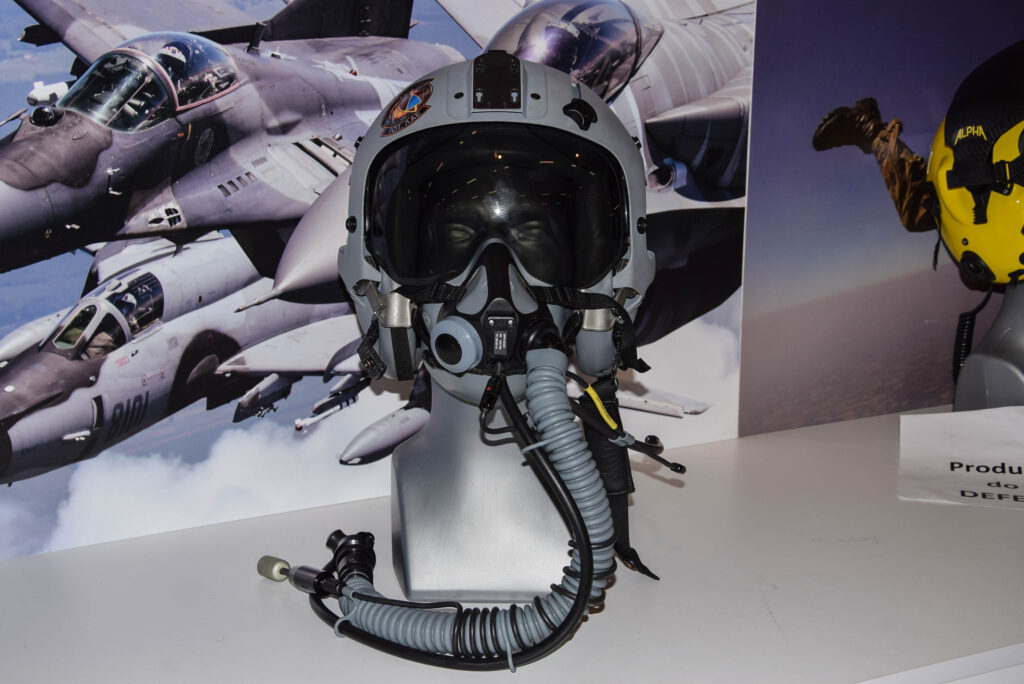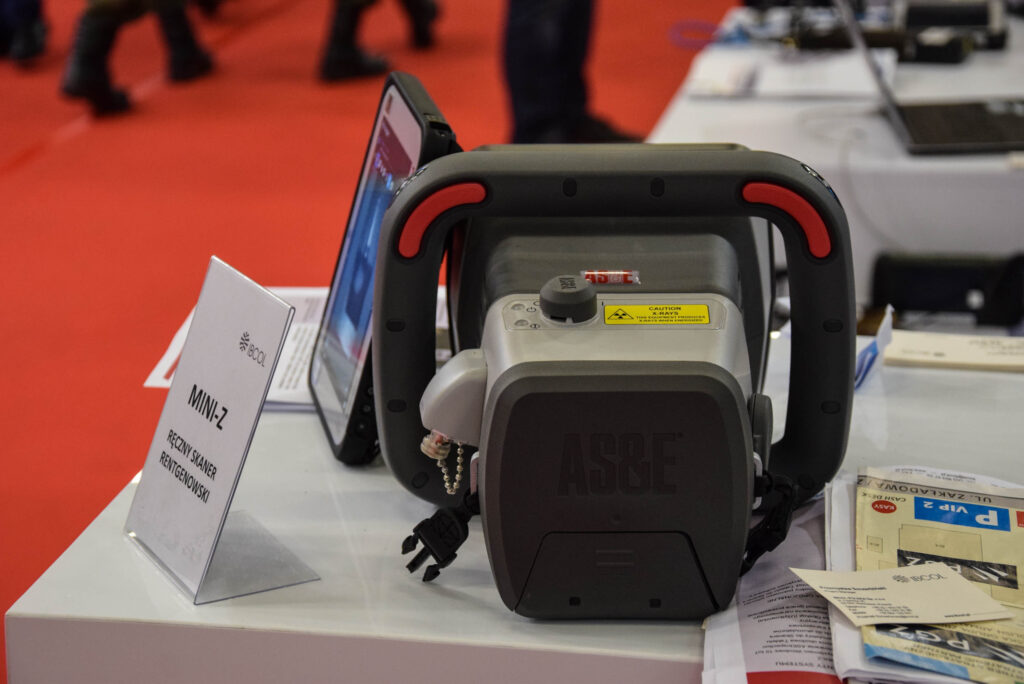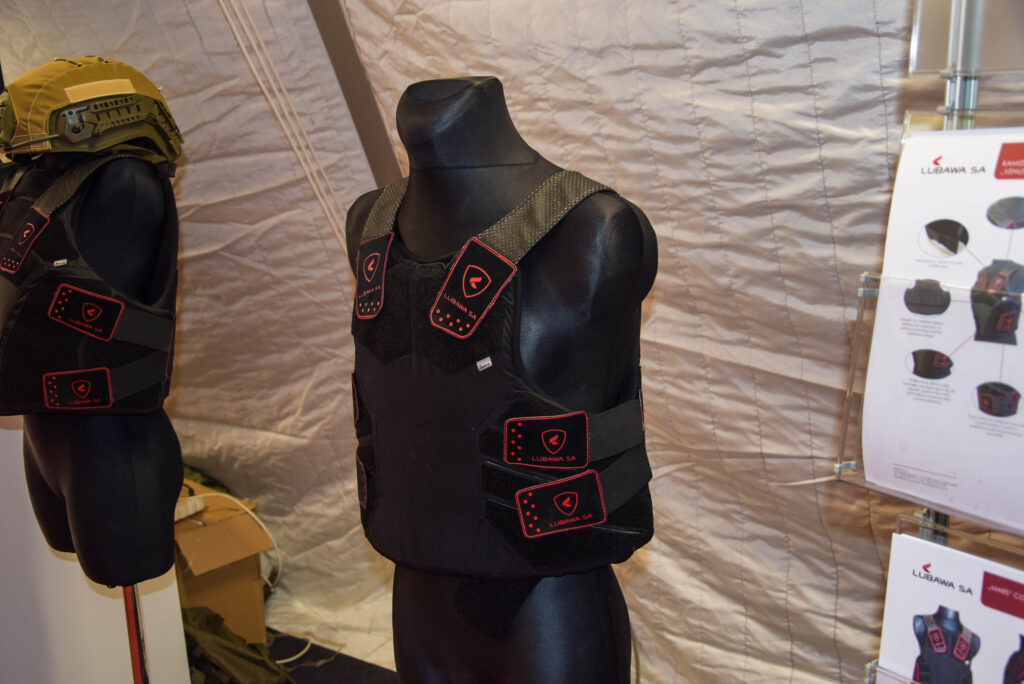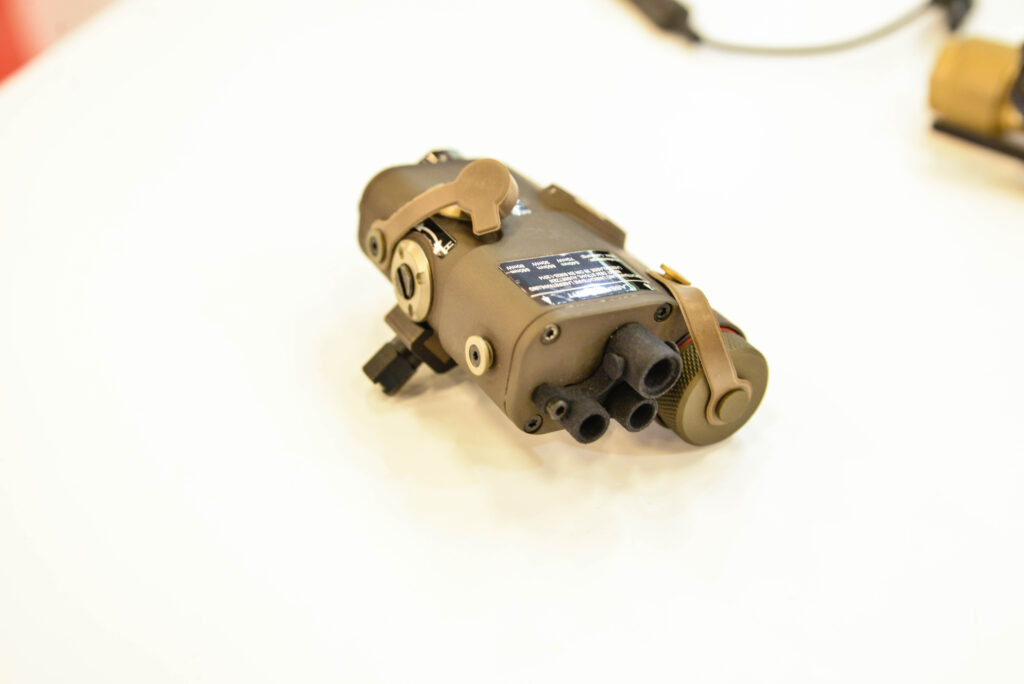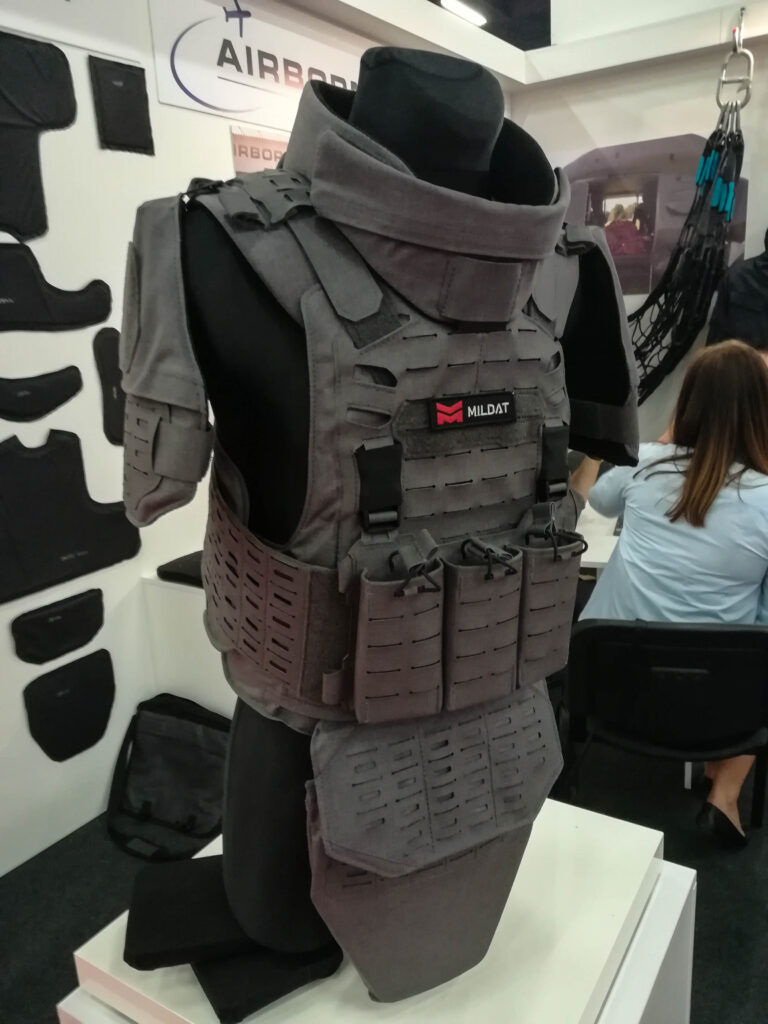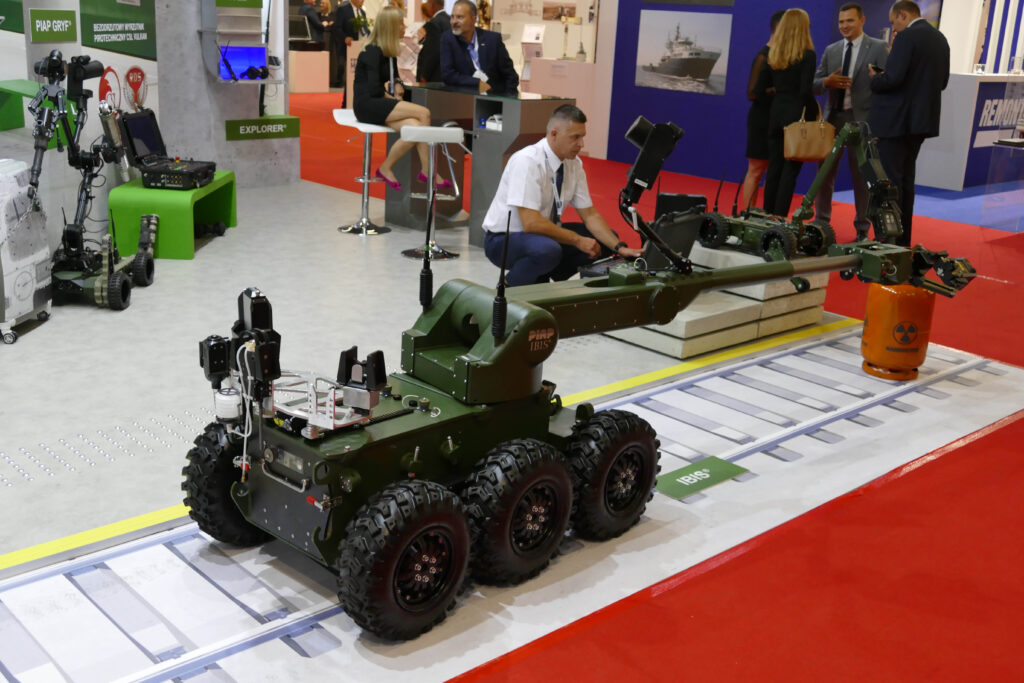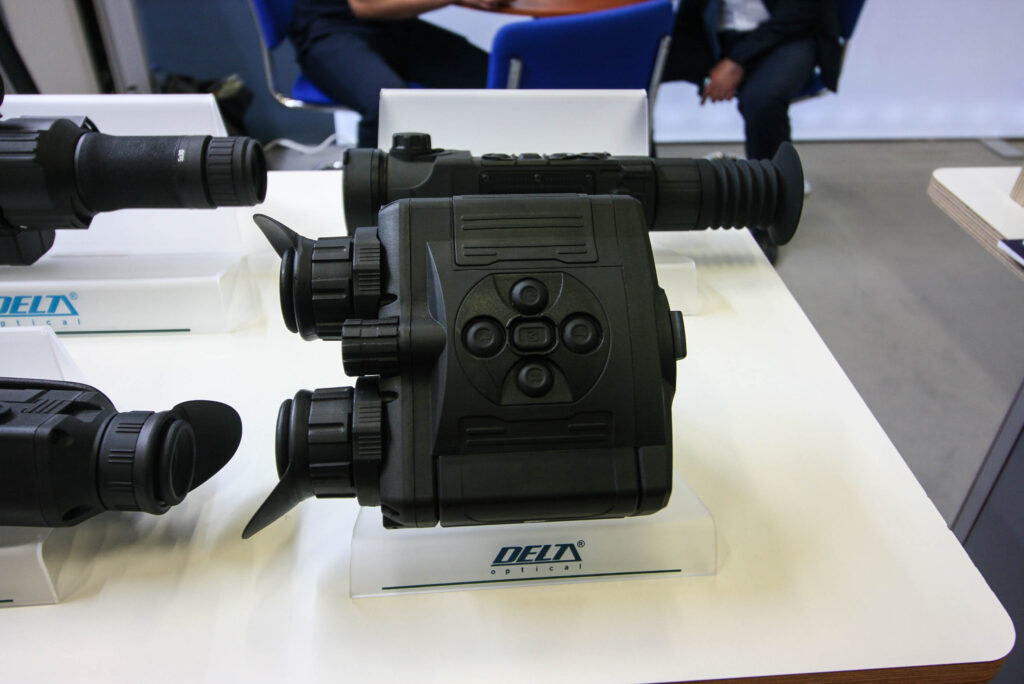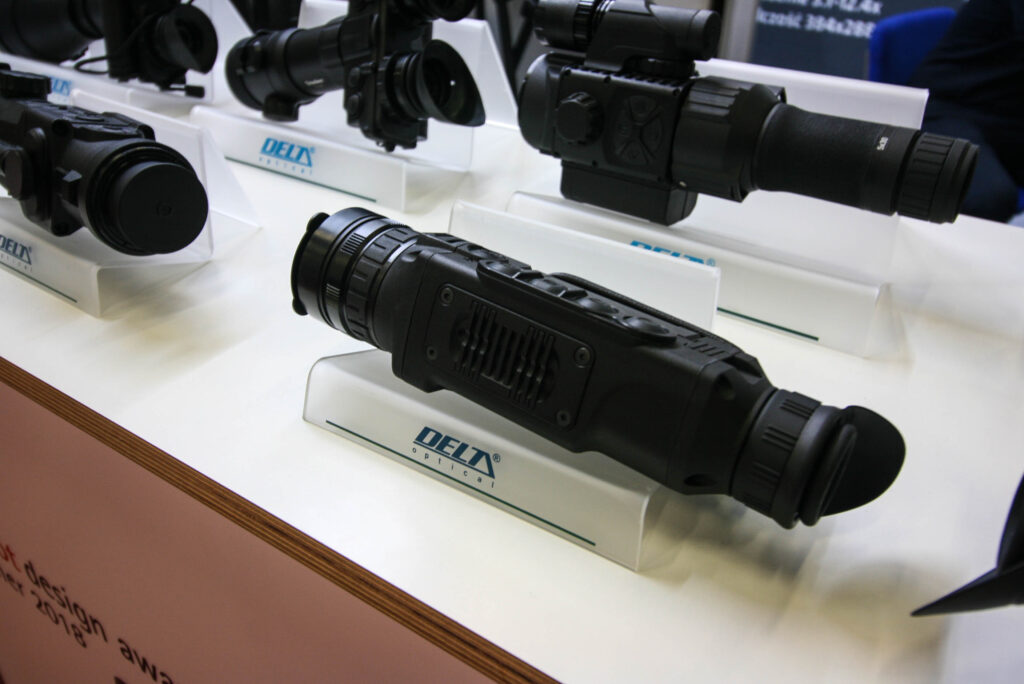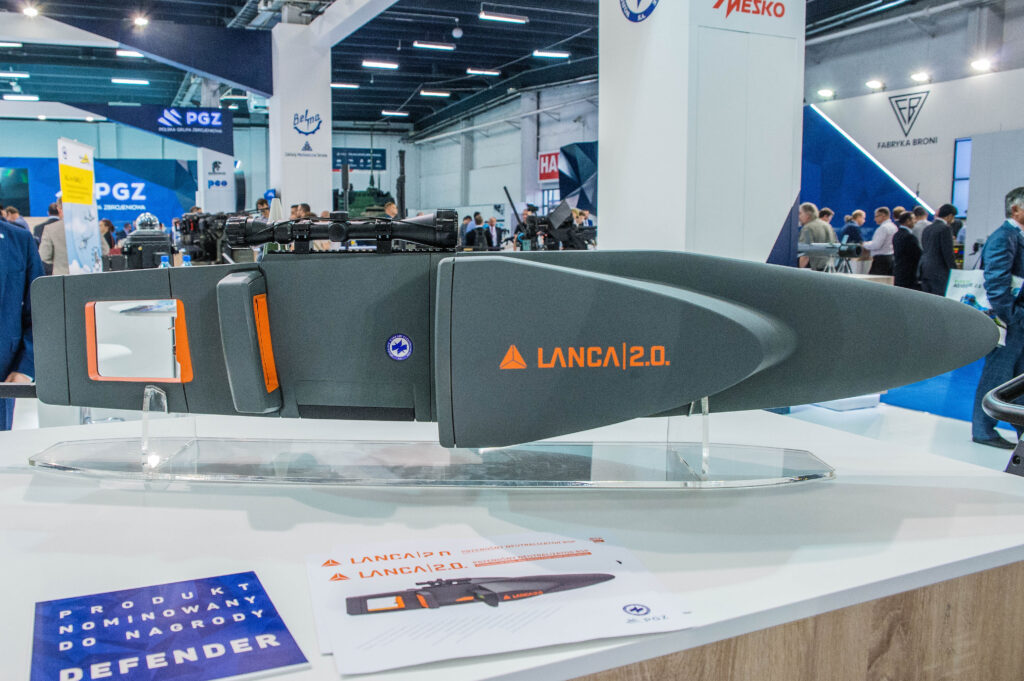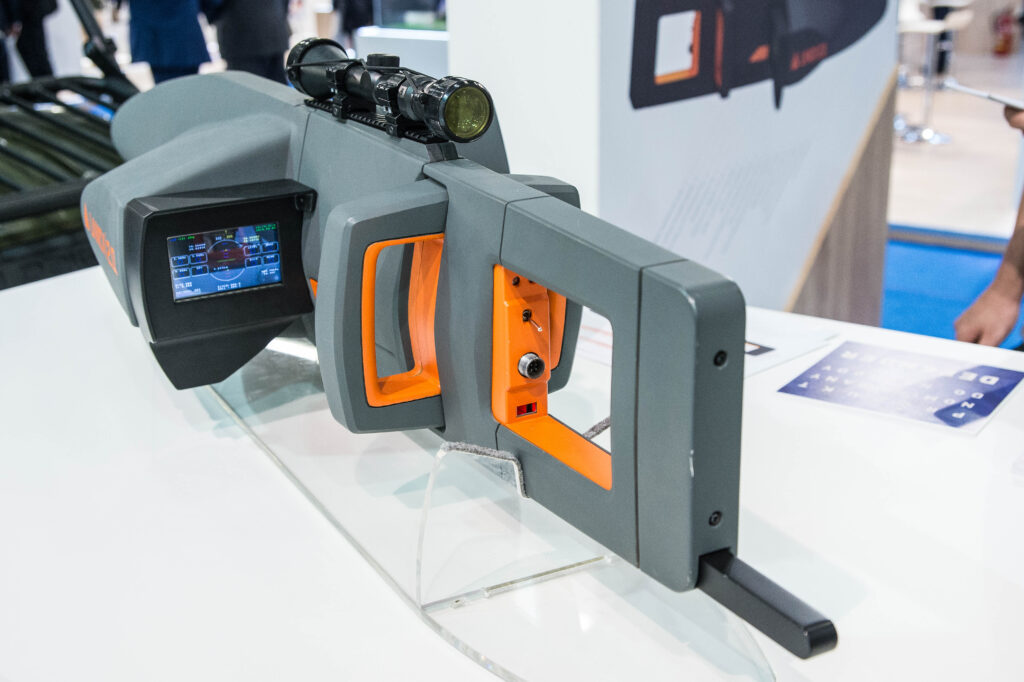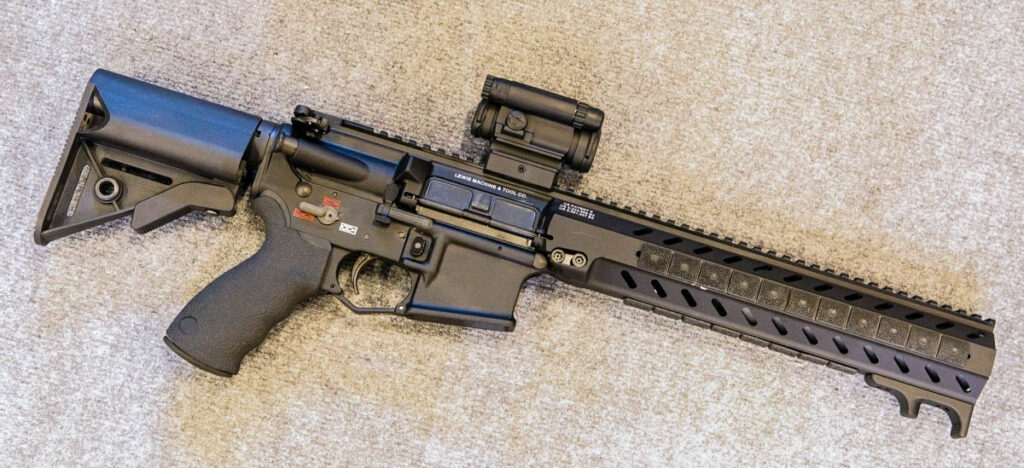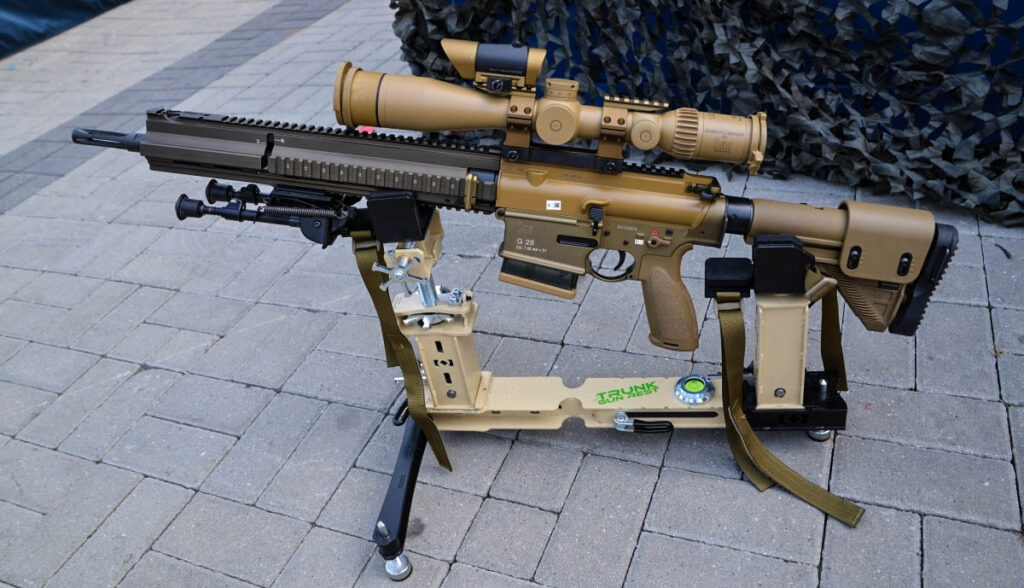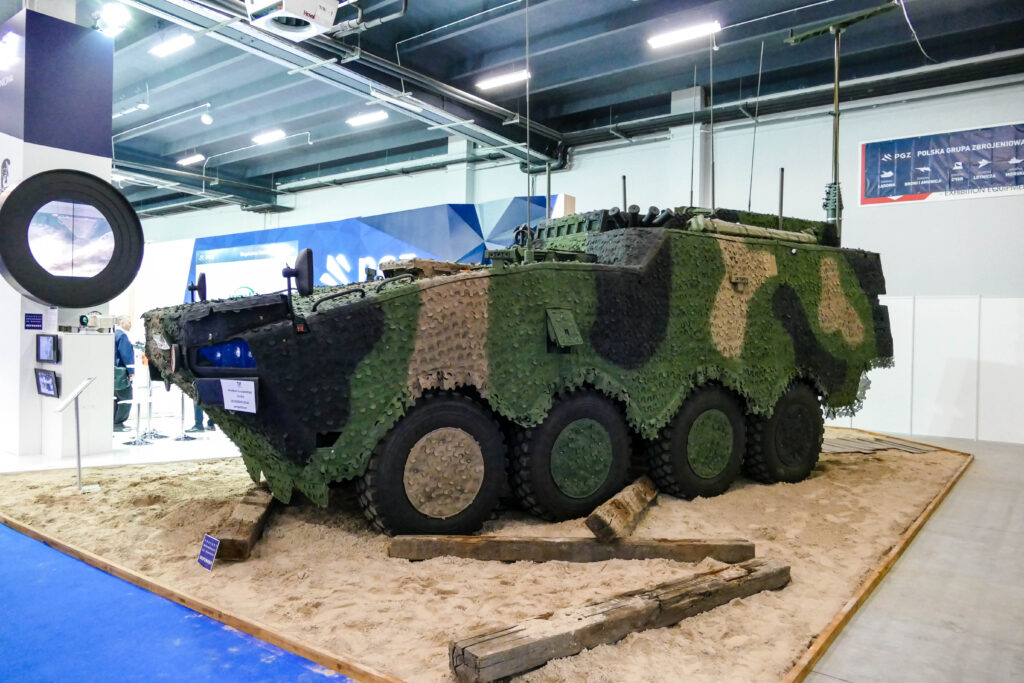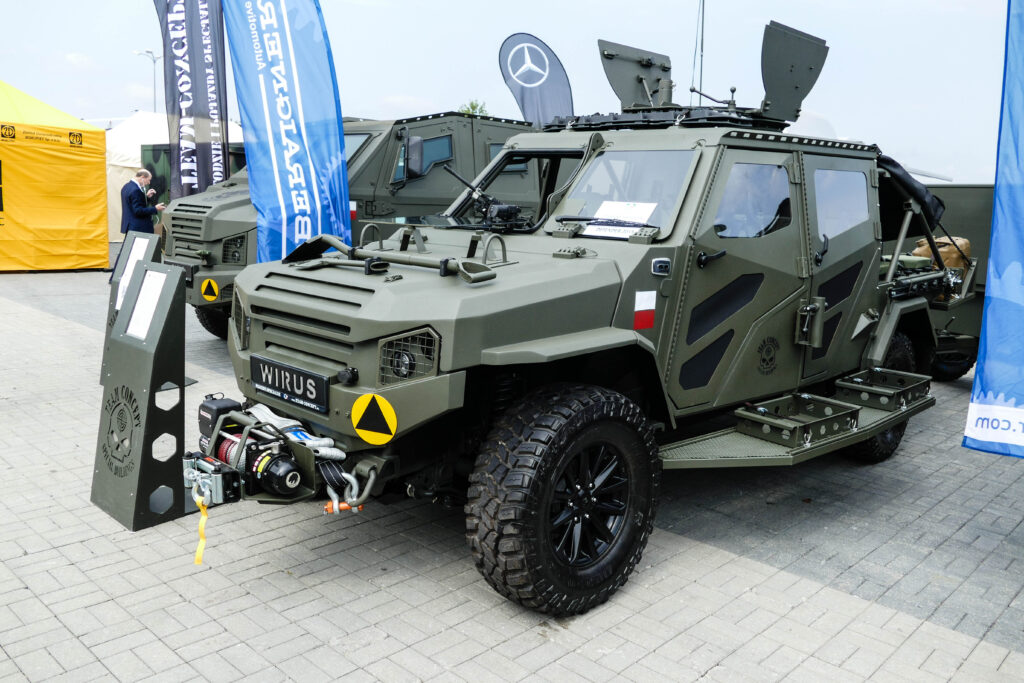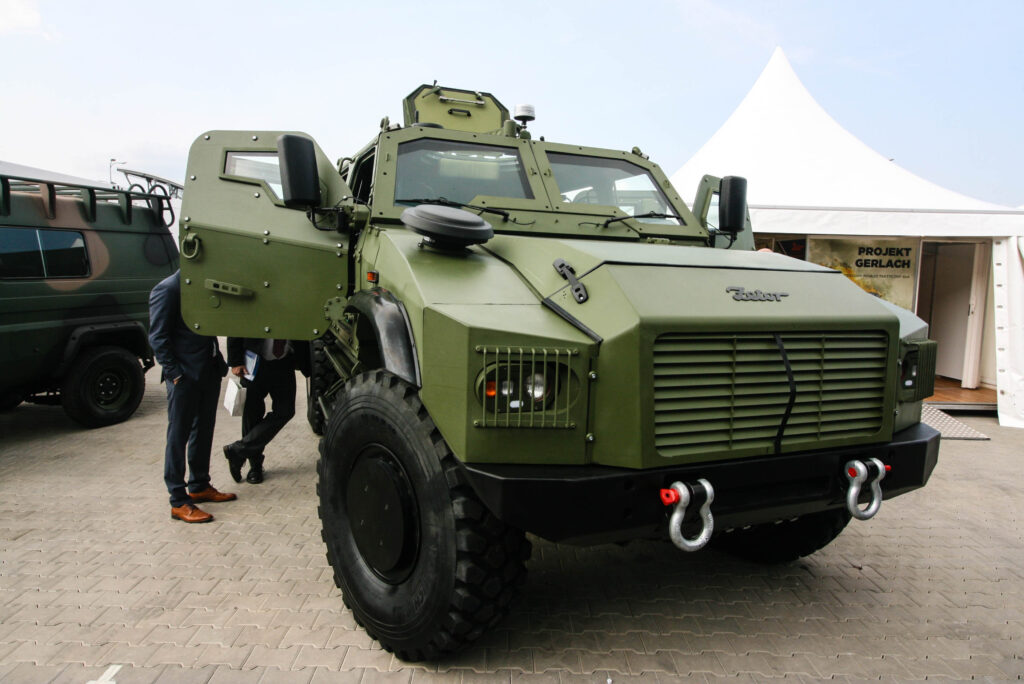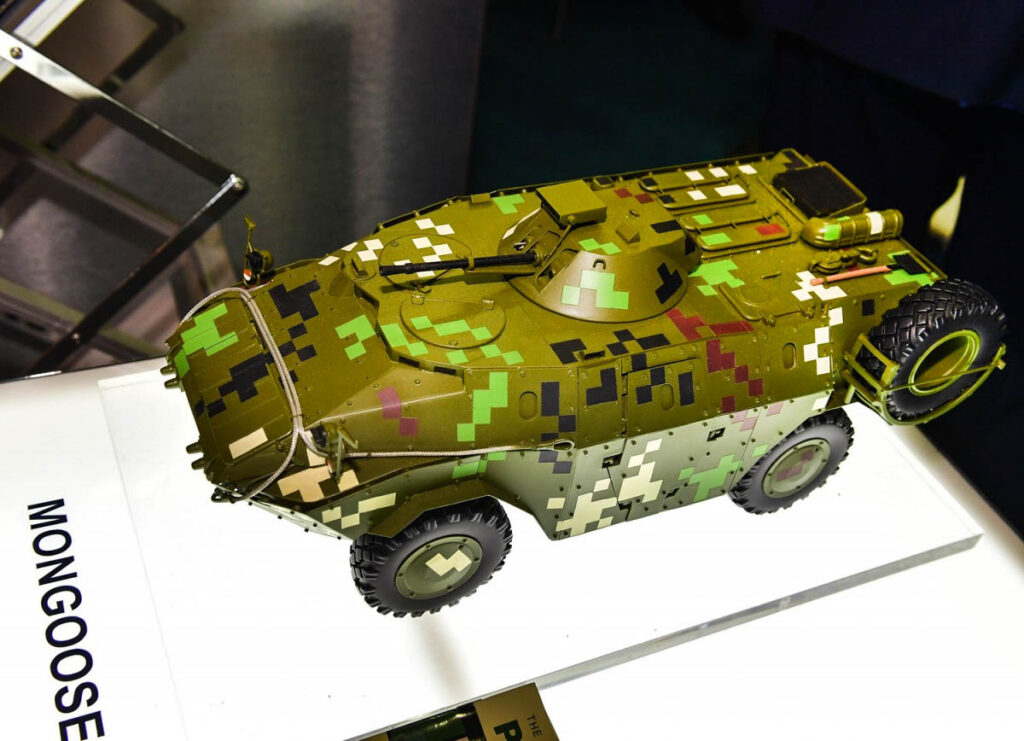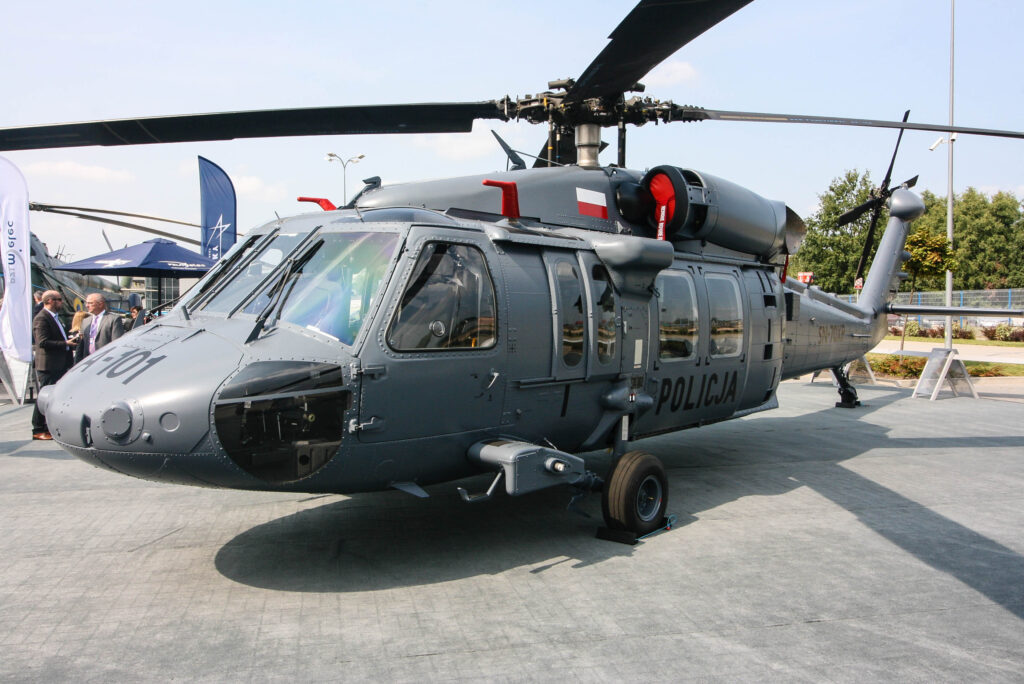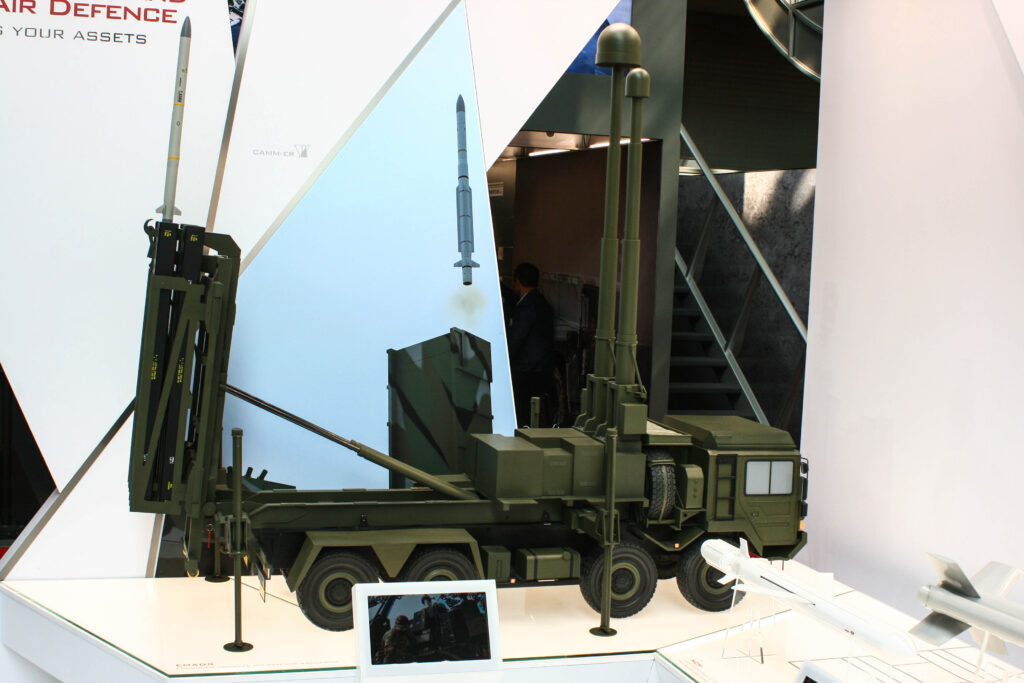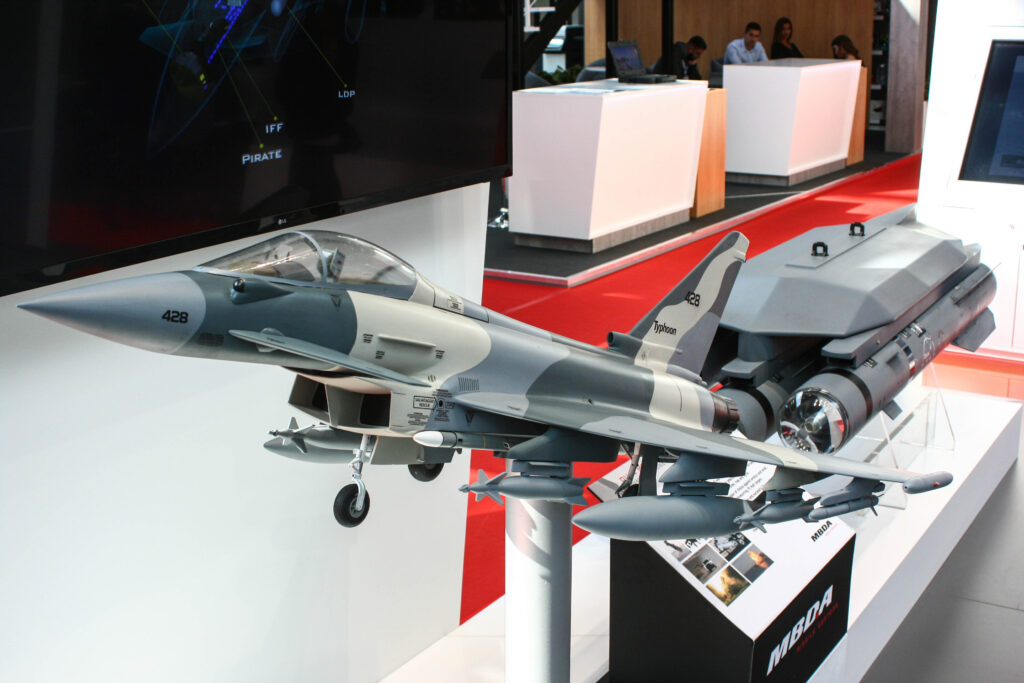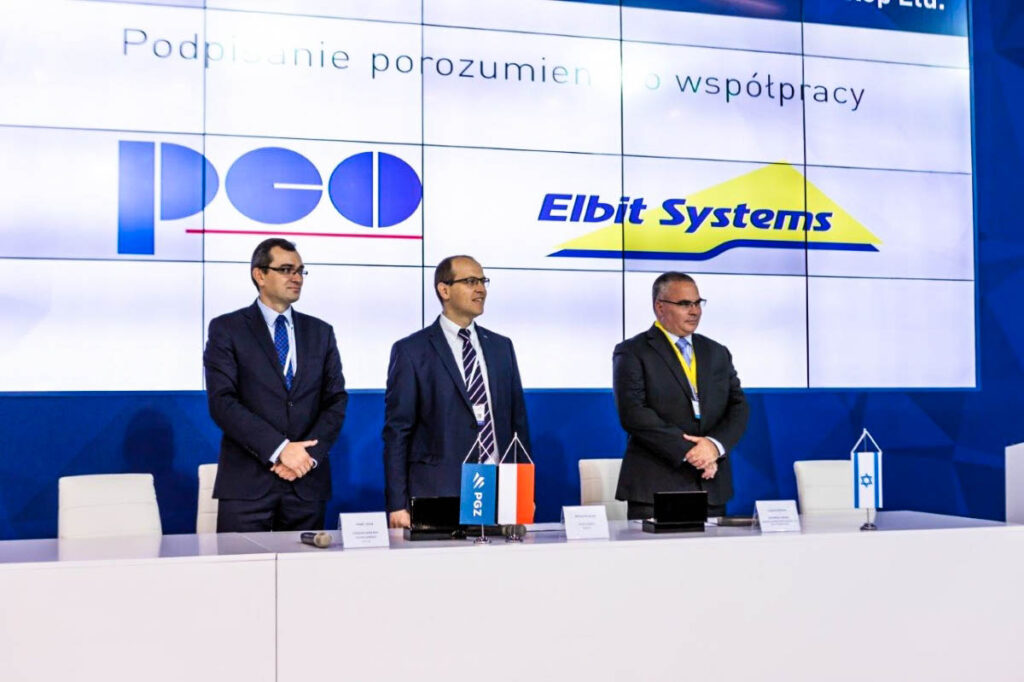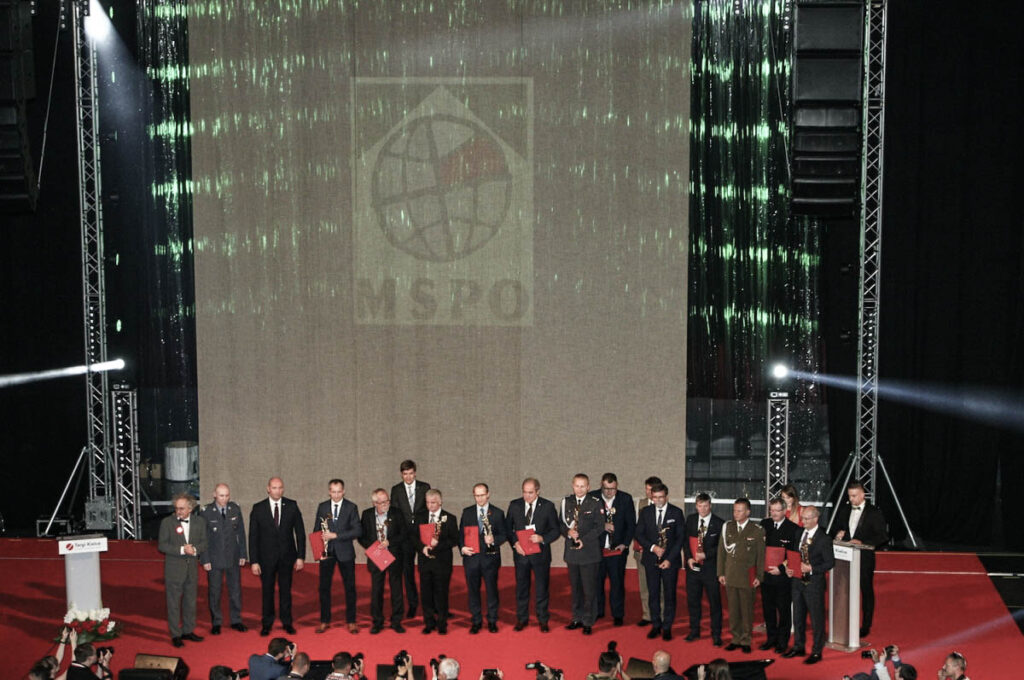ZMT Premieres
Zakłady Mechaniczne Tarnów (ZMT, Tarnow Mechanical Works) presented a lot of new products at the MSPO show. For the first time, new, light, 60-mm mortars designated LMP-2017 and LMN-2017M were shown. LMP-2017 has a quick-change barrel compatible with various types of 60 mm ammunition. It is currently offered to the Polish Territorial Defence Force. LMP-2017M is a modular design with an elongated barrel. It can be used in both commando version, lacking the bipod, and in the classic version with a bipod and a large base plate.
ZMT also presented modified SKW family of semi-automatic precision rifles chambered for 7,62 x 51 mm and 8,6 x 70 mm / .338 Lapua Magnum ammunition. Tarnow-based manufacturer showed off their design for modification of UKM-2000P zmod. The firearm was equipped with a shorter, 440-mm barrel, lighter stock, and other weight-saving modifications. The design was created with the Polish Army in mind and adapted to a role of an individually-carried machine gun. ZMT also presented a modified, 12,7-mm/.50 caliber WKB-Bm machine gun, fed from the left side.
Novelties from FB
At MSPO, Lucznik presented their bullpup family of Grot B/MSBS-5,56B rifles. The family, part of the RAWAT project, consists of the carabine, service rifle, rifle w/ grenade launcher, precision rifle, and machine gun. Two designs of the SKBW/MSBS-7,62N semi-automatic rifles also debuted in Kielce. The firearms are to fulfill the role of sniper rifles and differed in barrel lengths of 406 and 508 mm. The short one piqued the interest of the Territorial Defence Force representatives, while the long one is to become a replacement of the SWD rifle in the Polish Army. Both are undergoing strenuous tests by various military units including the Designated Marksman school from Torun. Thanks to such tests, necessary corrections can be implemented on-the-fly. More and more emphasis is also put on force on force training. As a result, another conversion for the MSBS system was shown at the Arms Factory booth during the show. Last year the UTM MMR-compatible bolt was shown. This year’s novelty is a conversion for the Simunition FX ammo.
Due to the 100 years of Polish independence, commemorative editions of Beryl S/Radom Sport were also presented. The final version of the Aktyn simulating system also gathered a lot of interest. It’s a fully domestic solution, designed and manufactured in Poland. Aktyn is compatible with normal firearms and with training replicas. It is used for urban combat training.
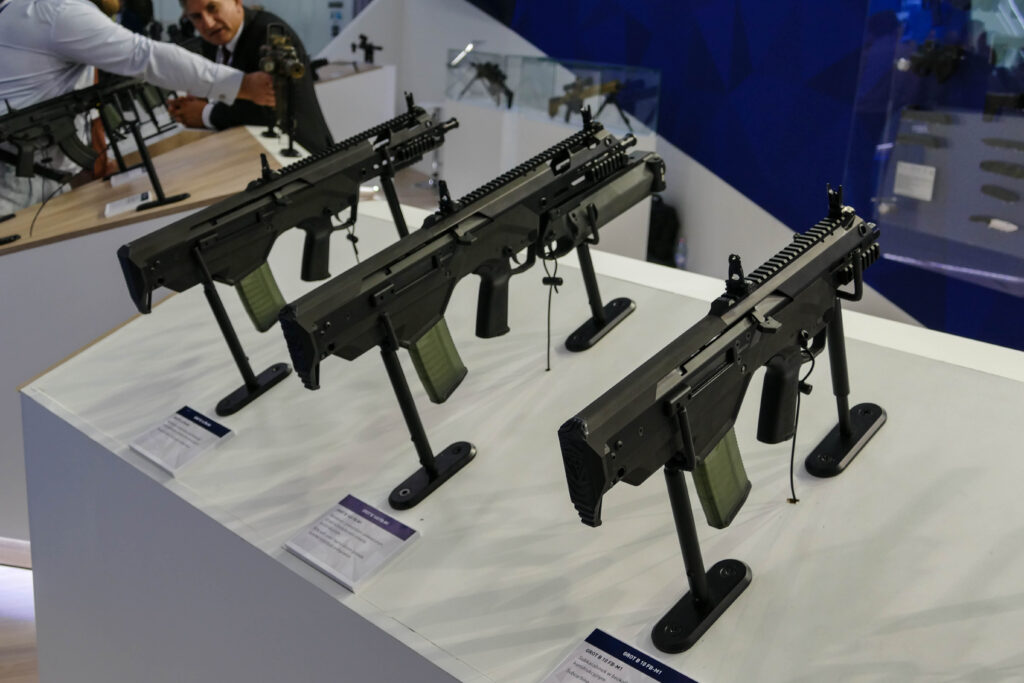
Szafir modified
company presented their modified DCM-1 Szafir (Saphirre) modular day scope at the MSPO in Kielce. Szafir consists of LDK-4 4×32 scope and an MK-1 collimating sight located on the scope’s tube. The modification was developed according to the requirement of Wojska Obrony Terytorialnej (WOT; Territorial Defence Force) which are the buyer in the procurement process for the modular scope.
DCM-1 changes concern mostly the functionality and ergonomics. The body was slightly modified to accommodate MK-1 sight placement in front and rear position without rezeroing. A composite cover for the RDS was introduced, as suggested by users of the previous version. This should prevent dirt from accumulating in the MK-1.
PCO also shortened the anti-reflex, honeycomb-style attachment for the scope which resulted in more light getting to the optics. The attachment is now threaded into the tube. The reticle was changed to LDK-4 to match the MSBS-5,56. Battery covers for the DCM-1 and MU-3M monocular night sight were unified.
Next modification does not concern the Szafir itself but the way the MU-3M night vision monocular is attached. Originally, the MU-3M had metal rails, compatible with universal accessory rails and was fixed in place by spring-loaded latches. The problem with DCM-1 was that regardless of MU-3M location, it’s battery compartment covered the MK-1 collimator. Additional mounting rail solved the problem and allowed for the monocular to be installed without compromising of the MK-1.
PCO is currently preparing a batch of DCM-1s for final testing in Territorial Defence Force. Manufacturer representatives claim that they are open for any suggestion regarding the future improvement of the modular scope. They also point out the potential changes could be introduced while the production is already running.
Territorial Defence Force plans to procure as many as 50.000 modular scopes. Interestingly, such a design (scope coupled with a collimating sight) wasn’t included in the Tytan programme. As MILMAG found out, PCO is ready to start deliveries within 2 years of the contract being signed, providing the agreement will be reached by the end of this year. It will take a year to start the production line and in the following year Warsaw-based manufacturer should be able to deliver the first 2000 of DCM-1s. The projected manufacturing capabilities for the consecutive years is 4000 units per annum. These figures can be increased if the Polish Land Forces will get interested in the DCM-1 sight.
2000 Grots for Territorials
At the start of September, the Arms Factory concluded delivery of another batch of MSBS-5,56KA0/Grot C16 FB-M1 service rifles. Two thousand of MSBS-es reached the Territorial Defence Force (WOT-Wojska Obrony Terytorialnej). Grot rifles are the part of this year’s deliveries of the newest FB product. Polish Armed Forces will receive 13,9 thousand of the rifles. Firearms will be used by Territorial Defence battalion formations. The process of replacement of wz. 96C rifles will start in 2019. These will be replaced in WOT by the MSBS-5,56KA1/Grot C16 FB-M2 iteration.
The delivery of 2000 MSBS-es was divided into 2 parts. First one numbered 1540, the second 460 of the MSBS-5,56KA10 Grot C16 FB-M1. Currently, there are 3250 of the MSBS system weapons in the Territorial Defence Force. By the end of 2018, first MSBS-5,56K should reach military schools in Wroclaw and Poznan. Such deliveries will enable the future officers and NCO’s to familiarize themselves with the weapon and its operating procedures.
Red P99 and REX for the Police
On the 21st of August, few days before MSPO start, Polish Police HQ informed that the decision was made in the proceedings for procurement of 965 9×19 mm handguns and 350 of P99AS dryfire training pistols. As expected, the training weapon contract was won by Radom Arms Factory. They were the only party to submit an offer for the training pistol. These weapons have a characteristic red frame and will cost PLN 672,000 (EUR 157,000). The unit price is PLN 1920 (EUR 448) and is warrantied for 13 years.
The choice of the service pistol is a surprise. Very broad specifications for the procurement allowed for the participation of both striker-fired and hammer-fired constructions. From 5 submitted offers, Police chose one provided by Works11. It is valued at PLN 1,46 million (EUR 341,000), with a unit price of PLN 1515 (EUR 354). The offer was scored at 100 points and was 78,000 PLN cheaper than one submitted by Arms Factory from Radom. The handgun chosen is the Arex REX zero1 CP, made in Slovenia. It’s a rare sight in Poland and almost non-existent in Polish law enforcement. For the last 20 years, striker-fired pistols such as P99 and G17/G19/G26 were popular. This time, police will receive a hammer-fired pistol with an aluminum alloy body and manual safety. Interestingly, handguns are procured without holsters or mag pouches – additional proceedings are soon expected to fill that gap. REX zero1 CP pistols are assembled by Works11 in Poland, out of Slovenian-made parts. Some components are sourced in Poland. Works 11 has the rights to the old logo of Zaklady Metalowe so the handguns delivered to the Police will display the number 11 in the oval.
Maskpol
At this year’s MSPO, PSO Maskpol (part of Polska Grupa Zbrojeniowa) presented 3 new patterns of MAPA camouflage. The new patterns are designated V2. In addition, tactical equipment for special forces was also showed as a presentation of the company’s capabilities.
The 3 new patterns were created by Ph.D. Maciej Dojlitko and are based on a different pattern than the original MAPA. It consists of a blurred and sharp objects which create a 3d effect and allows for color permeability resulting in confusion for a potential observer.
Three variants are designed for different climate zones, ranging from arid to heavily forested. A wide range of usability is achieved by precise choice of colors and contrasts. It’s worth noting that MAPA uses micro and macro patterns and works effectively for a wider range of distances. This is a contrast to current patterns, created with old methodology.
The second premiere from Maskpol was a set of tactical equipment. It consisted of a low profile plate carrier made of durastretch. The carrier has no traditional MOLLE/PALS webbing and has a 2-part, zippered ammo compartment. The zipper is located on the chest. It’s made of elastic fabric and laser-cut laminate. Additional pouches can be located on the outside and inside of the carrier. Equipment also comes with a belt sleeve, also made with laser cutting technology.
The modified HP-05 helmet is made of polyethylene. Improved, ergonomic shape was presented for the first time. The harness wasn’t changed but a new night-vision socket was used. In production models, it will be made from aluminum alloy. The helmet also uses a different color than typically used by Maskpol. The shape reminds a bit of Revision’s Viper helmet.
MILMAG Military Magazine also found out that Maskpol is cooperating with Karrimor. English company will provide different types of backpacks for the Dromader system.
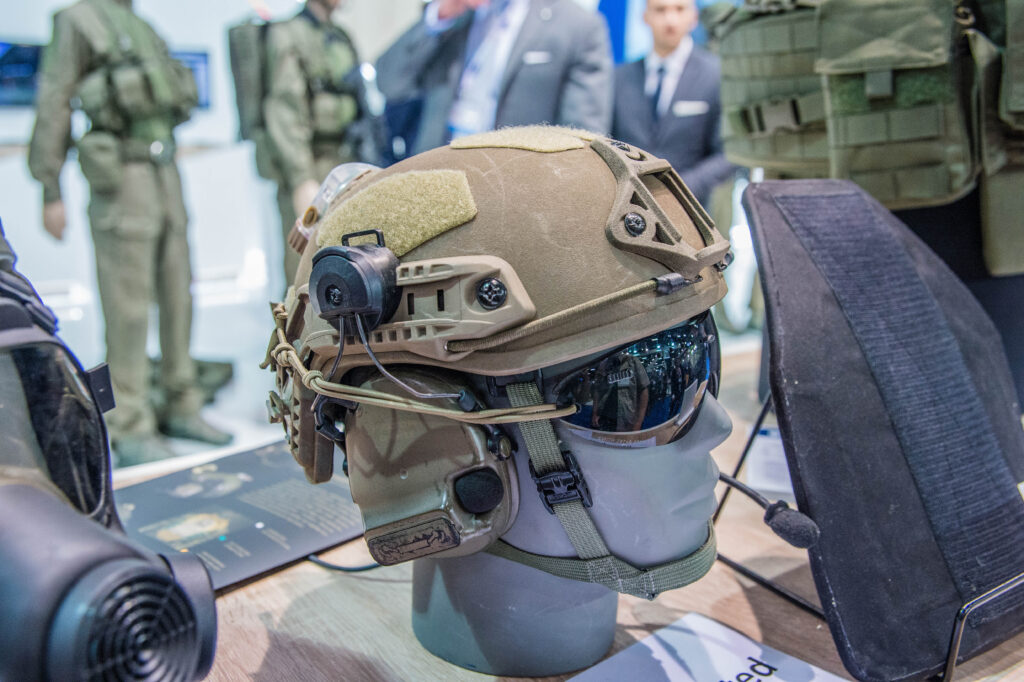
Gentex HGU-55/GTX for the pilots
This year, Kielce-based Parasnake presented the Gentex HGU-55/GTX helmets at the MSPO exhibition. These helmets were specially developed for Polish pilots of MiG-29, Su-22 and Iskra airplanes. The Gentex HGU-55/GTX, when compared to the last years HISL Alpha 900 SAR, is a head protection designed for pilots working on much higher altitudes and with a terminate ejection speed of 600 knots. The previously premiered helmet was destined for sea rescue pilots.
The helmet’s body is made of aramid polymers reinforced with carbon fiber. This makes for a quite light (1300 – 1400 g depending on configuration) construction. There are no large vents, characteristic to currently used ZSz-7 pilot helmet. This distinguishing feature was eliminated in the HGU-55/GTX and replaced with a special harness and sweatband.
The range of changes required for adaption of American helmet to Polish needs included lengthening of the oxygen tube (by 71 cm), replacement of the oxygen tube ends with suitable for onboard oxygen system and an introduction of 6,35-mm Jack-type adapter for powering the helmet systems.
HGU-55/GTX is one of the few helmets in the world prepared for emergency ejection at 600 knots maximum speed. Safety and head/face protection is achieved by the double-shielding system. Special socket for NV equipment was developed in such a way that ejection is safe. The socket is compatible with equipment from various manufacturers.
The changes made to a typical western helmet made it compatible with the needs of users working on Russian/Soviet equipment. Because of this the helmet was unofficially codenamed HGU-55/WARPAC (Warsaw Pact)
Interior equipment is constructed on an X-Liner design and together with elements made of high-quality natural leather provides comfort and stabilization even at great speeds.
HGU-55/WARPAC is compatible with HA/LP oxygen mask which was adapted for MiG, Su and TS-11 onboard system.
The low mass of the oxygen mask and special bayonet-type fastenings make this light protection infinitely more comfortable than the old ZSz-7 pilot’s helmet. Comfort and safety are increased with a double sight protection system for day/night operations and EDU-7/P standard against laser light.
Mini-Z Scanner
At the MSPO, Warsaw-based IBCOL company presented an X-ray handheld scanning system. Backscatter MINI-Z was created by the American Rapiscan Systems/AS&E. As MILMAG Military Magazine found out, the scanner was made available in Poland a week before the MSPO. The first device was already sold at the time of the trade show. The first Polish user is an undisclosed customs unit.
Small dimensions and backscatter capabilities allow for checking of locations inaccessible for other scanning technologies. MINI-Z will effectively scan car doors, lockers, wheels and tires, luggage, parcels, walls, furniture, boats, planes or interior of any vehicle. Contrary to density scanners, trace detectors or high-energy scanners, MINI-Z is fully handheld and provides real-time imaging of the scanned objects.
The kit consists of a MINI-Z scanner, rugged tablet, ASEInspection software, 2 batteries, charger, calibration panel, manual, shoulder belt, and an Ethernet cable for wired operation. All this is stored in a transport case which weighs 22,6 kg and measures 635 x 495 x 381 mm.
MINI-Z is a light and handy imagining scanner which utilizes Z-Backscatter technology. This solution is currently used by, i.a., Polish customs in their ZBV mobile x-ray systems. It allows for the detection of drugs, explosives, and other illegal materials. Scanning can take place in motion while driving alongside the scanned vehicle. It works when the contraband is placed in either the carried load or in the vehicle’s chassis. The scanner works in any weather conditions, up to 3000 m elevation and in 0-45 degrees Celsius temperature. The device can be stored in -40 to +60 degrees Celsius. Device-control station communication is facilitated by WiFi or Ethernet cable. The detector itself measures 292 x 249 x 193 mm and weights 5 kg. It works for up to 4 hours on a single charge. The accompanying tablet work time is 6 hours. An additional battery is included in the set. Scanning speed is 150 mm/s. The ASE Inspection software works on Windows 10 IoT Core. MINI-Z is equipped with a Polish user interface. X-rays are generated by a 10 W / 120 keV lamp. The device does not pose any danger to the operator or the nearby personnel. Scanner fulfills the ANSI/HPS N43.3-2008, ANSI, ICRP, NCRP and Euratom norms in regards to yearly radiation doses and is safe for the environment. It has an interlocking block to prevent unauthorized emissions and has been approved by the Polish National Atomic Agency.
USH Shields
The Kielce-based Parasnake company presented the ballistic shields manufactured by Swiss producer of ballistic protection – the Universal Shield Holding. Three types of the shield were shown at the MSPO. C.H.A.O.S. II (Combat Hazard Ops Shield), L.A.W.S. (Light Assault Warrior Shield) and R.U.Sh. (Rapid Universal Shield) are all suitable for use by firearm-carrying personnel. All are made of HPPE (High-Performance Polyethylene) and covered in either paint or Cordura fabric. All can be used in temperatures ranging from -50 to +70 degrees Celsius. Ballistic panels are under 10-year warranty while the rest (belts, additional lighting, stands, carry bag, etc.) are covered by 2-year warranty. All shields have 2-way ballistic protection. Enzo Battaglieri – the CEO of USH – explained that the shields can withstand fire from sharp angles and do not crack under powerful strikes to the edges. The surface prevents ricochets. Shields protect against shots fired with up to 7,62×51 mm NATO. USH products are quite light – C.H.A.O.S II weights between 3 and 12 kg and measures 800 x 487 mm. Thickness is between 10 and 29 mm. Only one size is manufactured but shields can be adapted to the purchaser needs. L.A.W.S. line measures 790 x 500 mm. It’s thickness and weight are the same as the C.H.A.O.S. shield. Sizes M, L, and XL are manufactured. Same goes for the R.U.Sh. line. Its M-sized shield measures 800 x 520 mm with a thickness ranging from 25-29 mm. Mass is 9-12 kg and the ballistic protection is at the IIIA level.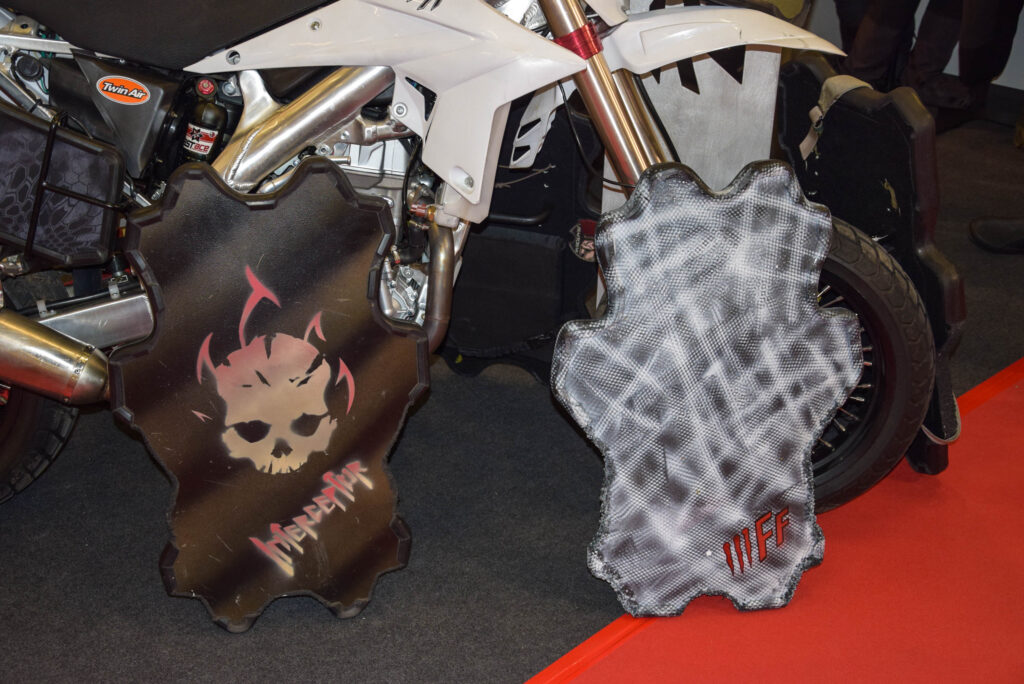
Defender MARS vest
During the MSPO 2018, Lubawa company received a special prize from the Police commander for the knife- and needle-proof low-profile vest. The vest is called MARS and is a textile vest to we used in concealed way under the clothing or uniform. It was created for officers who frequently are under threat of knife attacks. It protects the wearer against knife strikes of 24 J / 36 J force and against spike attacks with 24 J / 36 J force. The vest allows for freedom of movement while covering as much of the user’s body as possible.
In the L-size, MARS weights 2,38 kg. What makes it different from other similar products is the capability to stop needle perforations without using any extra accessories such as thin aluminum plates. This is critical for prison guards and police officers often coming under attack from blood-contaminated needles.
The exterior is made of durable textile. Colors do not transfer to the garments worn over the vest. Vest bottom is stabilized by an elastic belt. Shoulder straps are also elastic and equipped with velcro – this facilitates wide adjustment range in the vertical plane.
Horizontal adjustment is made by 3-point snaps which allow for tight fitting to the wearer’s body. Location and construction of the fastening buckles do not interfere with the external clothing. Ventilation is provided with a mesh underlayer.
Rheinmetall optoelectronics
During the MSPO in Kielce, Pagacz & Synowie company presented a range of new Rheinmetall products. The Torun-based company is a new Polish distributor of Rheinmetall. Laser target designators and laser range finders from the German manufacturer were the main focus of the presentation.
LLM-PI module, created for semi-automatic pistols, has a laser and a flashlight. The device can work in 2 modes – the visible light range (635 nm wavelength and 5 mW power) and the infrared mode (850 nm wavelength and 0.4 mW power). The flashlight is based on a LED which can emit 180 lumens and can work in constant and strobe mode. Power is provided by a single DL123 battery.
Another product presented at the MSPO was the laser VTA laser target designator/illuminator. The device was developed together with KSK (Kommando Spezialkräfte) special unit. It’s equipped with 3 LEDs (red, 640 nm wavelength, 70 mW maximum power), infrared light (850 nm wavelength, 30 mW maximum power), and illuminating light (830 nm wavelength, 75 mW maximum power). The manufacturer claims that the VTAL is compatible with all, currently used in service, night vision devices.
TAC-RAY BALLISTIC was a very noticeable absentee. It’s a tactical laser range finder equipped with a ballistic computer. It’s a Rheinmetall novelty and was developed for designated marksmen and snipers. The laser utilized in the device is invisible in night vision devices and allows for precise distance measurements for up to 2500 meters.
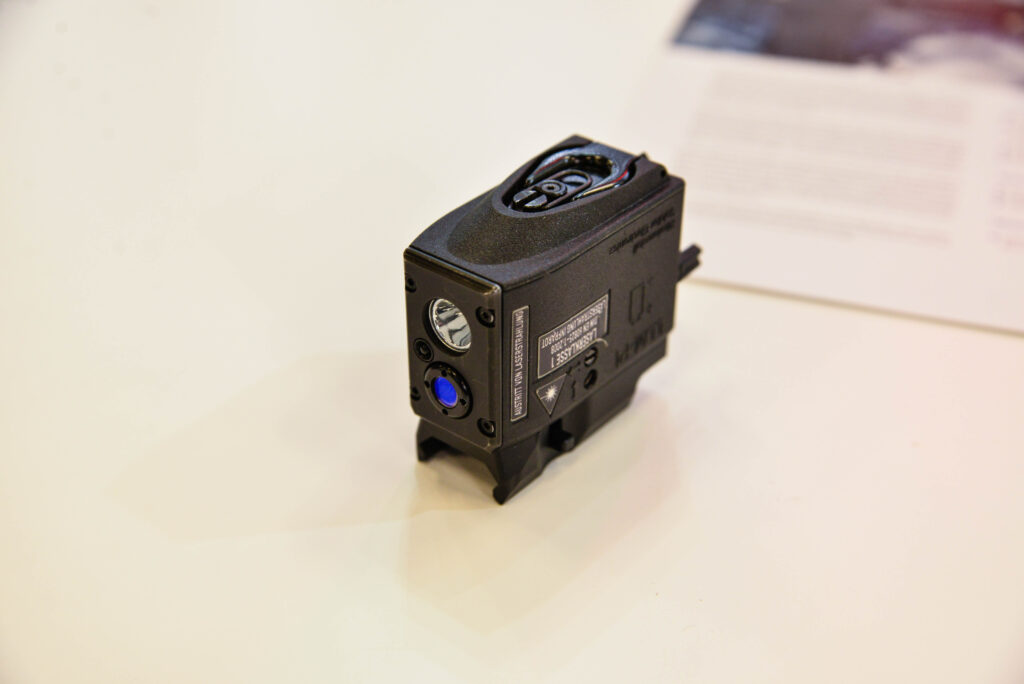
HAIX Nature
During this year’s MSPO in Kielce, HAIX presented the first models of their new NATURE line of footwear.
HAIX company, specializing in the manufacture of footwear for military and rescue services, widened their offer to include products for civilian users. The new line is destined for hunters and tourists. NATURE range was developed for use in forests and low parts of mountain ranges. Boots are demilitarized with traditional shoelaces in place of quick fastening system known from other HAIX products for uniformed services.
Two first models of the product range were presented: the GTX MID (15 cm high) and GTX LOW (7,5 cm high). The offer includes variants for men and women. When development is completed there will be 8 different models, introduced it stages through this and next year. Currently, manufactured boots are available only in brown-green color scheme.
Boots are made of nubuck leather, 1,6 – 1,8 mm thick and waterproofed with oil. GORE-TEX liner is utilized on the inside. Footwear is made of large pieces of leather to minimize the stitching and increase water resistance. There are no metal elements in the shoes. Sole is the same as used in other HAIX boots, like the BLACK EAGLE series. The sole’s model called HAIX MSL (Micro Soft Ligh System) and has anti-slip and vibration-reduction capabilities (lessens the load on wearer’s joints). Innersoles are also exchangeable and besides differences in length one of 3 widths can be chosen which allows for precise tailoring of the fitment to user’s foot.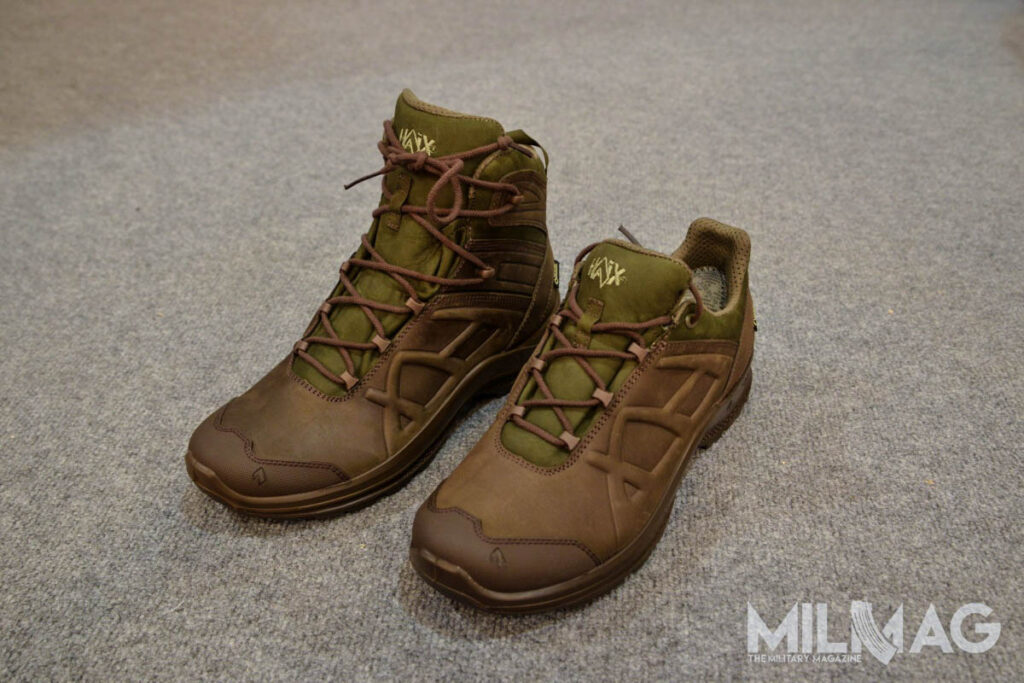
KNGR18 plate carrier
KNGR18 plate carrier was presented in Kielce by the Mildat company. It protects almost the whole torso with soft and hard ballistic protection. KNGR18 was created for an undisclosed Polish ordering party. The exterior was made by Templar’s Gear and is laser cut. It does not have typical MOLLE/PALS webbing. The ballistic inserts were certified by Wojskowy Instytut Techniczny Uzbrojenia to PN-V-87000:2011 norm and provided by JMD Daniel Technologie.
The vest is adaptable to the needs of various operators and weapon systems by utilization of fastex and velcro panels. Fastex buckles spacing is the same as used by Haley Strategic Partners, Spiritus Systems etc. The vest can accommodate front and rear ballistic plates made of ceramic-composite materials. The K3ABC class panels can stop 7,62 mm x 39 PS, 5,56 mm x 45 SS109 i 7,62 mm x 51 M80 bullets. The lighter, K3AC stops 7,62 mm x 51 M80 i 7,62 mm x 39 PS. Smaller sized equivalents of the K3AC are used in the side panels. Additionally, front, rear, and sides are protected with K2 class soft inserts protecting against 7,62 mm x 25 ammunition and V50 shrapnel up to 600 m/s.
PIAP's new releases
Industrial Insititute for Automation and Measurements (Przemyslowy Instytut Automatyki i Pomiarow – PIAP) presented specialized equipment for combating threats of NBC nature. Ibis robot, with an auto sample collection, was presented in Kielce. This platform was designed for EOD and reconnaissance tasks and is able to automatically collect samples of possible biological, chemical and radiological materials. When accessorized, Ibis can also neutralize dangerous items, conduct chemical reconnaissance and work in rescue activities.
British CSL pyrotechnical launchers were also premiered at the MSPO. PIAP is their main distributor for Polish and foreign markets. Vulkan launcher (CSL 50-40 VUL) is a modular, recoilless device capable of firing various-mass projectiles. It can be configured for neutralization of dangerous devices or as a support for antiterrorist units. Optionally, the launcher is also able to fire 40 mm x 46SR grenades.
Delta Optical Thermal Imaging
A whole range of scopes, binoculars, and optoelectronic devices was shown in Kielce by Delta Optical. One of the shown items was the Pulsar Accolade XP50 thermal imaging binoculars. These bions are based on a microbolometric matrix with 640×480 px resolution. It’s made in 17 micrometers technology and has a 50 Hz refresh rate. Such parameters allow for differentiating between a wild boar, dog, and a human. This is important as thermal imaging is getting more popular with hunters. The working temperature range of -25 to +50 degrees Celsius also makes it useful for hunting. Control buttons are located on the top of the XP50 and ambidextrous. Eight imaging modes are available: two monochromatic and six color. One of the modes can be used for examination of building insulation. Buttons are rubberized and the whole device has IPX7 class of water resistance. Binos can connect to any iOS or Android device and the image can be transferred in real time. The current price of the Pulsar Accolade XP50 is PLN 6000 (EUR 1400).
The second interesting device shown by Delta Optical is the Pulsar Helion thermal scope. It’s offered in 6 different configurations with lens sizes of 28, 38 and 50 mm. Weight is 400, 450, and 500 g respectively. Detection range for human-sized objects is up to 1800 m. Helion has a photo and video capability and 8 GB of internal memory. The simple XQ 38 version had 384×288 px matrix and works for up to 1000 m for human-sized objects.
WZE Lanca 2.0 UAV neutralizer
Wojskowe Zaklady Elektroniczne (Military Electronics Works) presented a development version of their Lanca portable UAV neutralizer. The new one is called Lanca 2.0 and resembles a handheld firearm. The previous model consisted of a backpack energy source and an emitter attached to a normal rifle. Lanca 2.0 has a standby mode which allows for immediate use when a UAV is spotted in the protected airspace.
Lanca works by jamming the GPS and control signal of the target drone. This should turn on an emergency landing procedure and safely land the aircraft. This technology works for less advanced drones which lack the return to start point procedure when no signals are being received. Future versions of Lanca might also be equipped with an EMP feature.
Lanca 2.0 has an effective range of 1000 m and the jamming signal can be emitted for up to 120 seconds, after which a break is required. Whole set weights 10 kg but the creators are planning to reduce this by half. Size will also decrease, roughly to a size of standard service rifle.
The device is modular and the user can decide what modules and jamming capabilities are required. Neutralizer screen can be placed either left or right side. Lanca 2.0 can stay up to 4 hours in the standby mode but the manufacturer points out that this equipment was developed for storage in the charging station, not for long, autonomous actions. Lanca can be additionally powered from a backpack battery or a 12V DC car battery.
LMT CSW rifle
Warsaw-based Mex Armory debuted at the MSPO show. This young company has been founded at the beginning of 2018 as is a distributor of Lewis Machine & Tool rifles, including the CSW (Confined Space Weapon) integrally suppressed rifle. The CSW upper receiver underwent trials in the SUGR (Suppressed Upper Receiver Group) program organized by the US SOCOM. The weapon was developed for government use and chambered in 7,62 mm x 35/.300 Blackout. CSW is equipped with an integral suppressor located under the handguard. This reduces the length of the rifle and prevents accidental burns of the user or the accompanying working dog. Barrel’s length, together with the suppressor is 12 inches / 305 mm. The barrel itself is 7 inches / 178 mm. The manufacturer claims 10,000 shots life. The rifle has a quick-change barrel system, based on 2 Allen bolts. These are located on the right of the handguard. Handguard itself is an integral part of the upper receiver. The rifle is fully ambidextrous – all manipulators are located on either side of the lower receiver.
CSW has a medium-length SL-8 Slick handguard. Accessory rails can be fitted with extra bolts. Due to the internal suppressor, the manufacturer decided not to use the Key-Mod or M-Lok system and replaced it with their own SL-8 system. To shorten the rifle, return mechanism guide and stock are reduced in length. Bolt carrier was weighted to improve the reliability. Lower receiver was made according to the MARS-L (Modular Ambidextrous Rifle System-Light) system and has ambi controls. Charging handle is also bilateral.
Trunk Gun Rest zeroing base
During the 2018 MSPO, Cenrex presented a weapon zeroing base called Trunk Gun Rest. It was developed by the Joter Goleszow company and designed by Jurand Szweda. The gun rest is very portable when collapsed and can be easily carried in an included case. It’s made mostly of steel and weighs 9,5 kg – a good compromise between mobility and stability. The device consists of 3 major elements: length-adjustable base with 3 folding feet, and 2 quick release columns, adjustable in both horizontal and vertical planes. These columns support the handguard and the stock of the weapon which is then immobilized by polymer webbing. The device also has a built-in spirit level. Concept work and prototyping took place in 2016 and 2017. Testing and refinement of details took another year. Pre-production models are currently available from Cenrex.
Rosomak WD premiere
Polska Grupa Zbrojeniowa (PGZ) presented a prototype of a new command vehicle based on the Rosomak APC. The vehicle is called Rosomak WD and 7 of those already reached the Command Support Regiment (Pulk Wsparcia Dowodzenia) – part of the Multinational Division North East Command (Dowodztwo Wielonarodowej Dywizji Polnocny-Wschod). Rosomak WD enables the commanding officers to control the subordinate units while stationary and when moving. The vehicle is equipped with communication and software packages allowing for rapid decision-making and information exchange up to NATO Secret status. Rosomak WD is protected against signal leakage and any forms of eavesdropping. Its creation was started by a contract from 9th of March 2018. The contract is valued at PLN 80 million (EUR 18,7 million) and the prototypes were developed within 6 months of contract signing. WB Electronics is the key manufacturer of the information and communications technology systems for the vehicle. Rosomak WD has a modified ceiling, 7 antennas, and new climate control. Changes did not affect the driving characteristics. The vehicle is crewed by 7 soldiers, there are 5 workstations available. New command vehicles are equipped with the Miranda multi-spectral camouflage. Visually, it imitates the natural textures of the surroundings and protects against detection with an augmented and unaugmented eye. Miranda also has reemission capabilities and camouflages against NV devices. The thermal footprint is reduced by up to 85% and the radar can be damped to 20 dB level.
LPU Wirus 4 SOF
Concept company unveiled the new version of their LPU Wirus (Lekki Pojazd Uderzeniowy; Light Strike Vehicle) vehicle. The newest iteration is called Wirus 4 SOF (Special Operation Forces) and was developed with special forces in mind, in cooperation with an undisclosed party. It has loading baskets for additional equipment, fuel, ammunition, food, etc. When viewed from above, the new vehicle is wedge-shaped. This allows the rear seating passengers to fire forward with the vehicle-mounted 12,7-mm/.50 cal machine guns or 40-mm automatic grenade launcher. Wirus is still under development. In 2017 it was chosen in the Zmija (Viper) program for a long-range reconnaissance vehicle. When compared to the previous version, the current one is longer and has bigger load compartments.
Wirus SOF is powered by a 2,4-liter diesel engine developing 180 BHP and 430 Nm of torque. It has a 4×4 drive, central differential, low range box, and 3 diff locks. The front suspension is coil sprung, independent, with 2 wishbones. Rear has a solid axle, double wishbone, and Panhard rod. Sway bars are located in the front and rear. The vehicle is equipped with disc brakes in the front and drums in the rear. It runs on 315/70R17 all-terrain tires. The electrical system is 12 V. Total length is 5000 mm and the width is 2050 mm. Height is 2050 mm and the wheelbase is 3000 mm. Gross vehicle weight is 3000 kg and the payload is 1000 kg for the base version and can be increased to 1500 kg. Under-axle clearance is 240 mm, the approach angle is 40 degrees, departure angle is 35 degrees and the break over angle is 30 degrees.
The presented variant had a closed body, developed for low temperatures. The built-in heater keeps the interior warm. Base version can transport 4 soldiers but in an emergency, 8 people can fit inside. Wirus SOF has a rotating turret and other fixing points for weapons. Concept also presented a special trailer developed for air-mobile troops. The trailer is based on the same concepts as the LPU Wirus.
Zetor Gerlach
Czech-based Zetor Engineering CZ presented the Gerlach 4×4 armored vehicle at the 2018 MSPO. The vehicle can be offered as a part of the Polish Pegaz and Kleszcz programs concerning procurement of the vehicles for various branches of the Polish Army. The world premiere of this vehicle took place in May 2018, during the IDEB show in Bratislava. At the time vehicle was to take part in the Slovakian program for replacement of the BAE Systems RG-32M Scout, Aligator, and BRDM-2 vehicles. The manufacturer envisions the development of 5 production versions in 3 GVW classes. The AFV 4×4 vehicle concept was created in 2016 in close cooperation with Zetor Engineering Slovakia.
Gerlach is 5,65 m long, 2,5 m wide and 2,5 m high. It has a carrying capacity of 1500 kg and a GVW of 12000-12500 kg. Turning radius is 7,5 m and the wheelbase is 3,6 m. The vehicle is capable of crossing vertical obstacles to up to 50 cm, 70% inclines, 90 cm ditches and can wade in water up to 120 cm deep. Gerlach is armed with a single, manually-operated machine gun, or a remote control weapon module. The cabin is ballistically protected at the STANAG 4569 Level 1 but this can be increased to Level 3. Blast protection is at 2a level (3a/3b as an option). The underside is double-layer, V-shaped. Zetor Gerlach is equipped with modular armor and can carry, depending on configuration, 4 to 6 fully equipped soldiers. The vehicle is powered by a 326 BHP diesel engine connected to a 6-speed automatic gearbox. Maximum speed is 110 km/h and the range is 800 km. Fuel capacity is 220 liters.
BRM Mangusta
Ukrainian SE PromOboronEksport signed an agreement with Poznan-based Wojskowe Zaklady Motoryzacyjne (WZM) on the 7th of September. The agreement concerns the modification of the BRM Mangusta wheeled reconnaissance vehicle for the Polish program for procurement of the light, armored reconnaissance personnel carrier. During the Polish-Ukrainian talks, possible development of the vehicle, previously known as BRDM-NIK, was discussed. A mockup of 2-axle, amphibious vehicle was shown in Poland. It would have independent suspension and 4 wheel drive. Maximum speed is to be 100 km/h. Carrier would have egress hatches on its sides (similar to BTR-70/80), top, and the rear. Additional modular front armor is to increase the crew survivability. The average thickness of the main armor is 10 mm. Additionally, reactive armor panels could be fitted to the vehicle. Armament would be the same as in the BRDM-2. BRDM-NIK prototype was first presented at the Arms and Security show in Kiev. All components, bar the Italian Iveco Tektor engine, were developed in Ukraine.
Black Hawk for Police
The first of two Sikorsky S-70i Black Hawk helicopters purchased by the Polish Police was displayed at the MSPO show. The helicopter was assembled at PZL Mielec and already had the correct color scheme, registration mark, and tactical number. Black Hawk was procured to fulfill support role for the antiterrorist BOA unit of the Polish Police. It’s equipped according to the ordering party requirements with a range of solutions. One of these is the main rotor brake, typical for naval helicopters. It allows for keeping the engine running at full power while stopping the rotor. This result in safe and quick loading and unloading while maintaining readiness for rapid takeoff. The Police Black Hawk also has a winch. Current arrangements allow for 12 passangers. Avionics systems were simplified – the typical combat systems were removed. This lowered the weight and decreased the price. The helicopter can be sold directly by the manufacturer, without involvement from the federal government necessary when the key technologies are present. During the talks, manufacturer representative informed that they are developing a modernization proposition for the S-70i helicopter based on the Polish Navy requirements. The proposed modification would work out cheaper than the purchase of the SH-60 Sea Hawk.
MBDA aims for Narew
In Kielce, during the 2018 MSPO exhibition, MBDA consortium presented their proposal for the short-range anti-air CAMM system, which will be offered to Poland for the Narew programme.
CAMM (Common Anti-Air Modular Missile) is the newest system in MBDA offer. It’s based on modular missiles fired from vertical launchers and can be utilized by land forces as well as the navy. Royal Navy Type 23 frigates are armed with CAMM system. One of the advantages of the MBDA system is the cold start technology which enables the missiles to be safely launched from small launching platforms such as decks of small vessels or in the urban environment. Thermal trace of the launch is also decreased which allows for better concealment of the launch itself.
The system is based on 2 types of missiles: CAMM (with a range of 1 to 25 km) and CAMM-ER (with extended range). It’s worth to point out that the launchers can be integrated into the existing airspace control system. Successful guiding of CAMM missile requires data link to the detection equipment to pass on the target location.
MBDA representatives claim that sale of the full CAMM system together with technology transfer is possible. This was enabled by the Polish-British bilateral military cooperation agreement. The system can also be partially polonized – it could be integrated into the existing radar network and the launchers could be fitted to trucks manufactured in Poland.
Interestingly, MBDA tested their effectors with various European and American anti-aircraft system.
During tests in the USA, CAMM was able to successfully fix and intercept the target while receiving data from the ICBS system.
Eurofighter for Harpia program?
During the MSPO exhibition in Kielce, the consortium of Airbus, BAE Systems and Leonardo presented a multi-mission new generation Eurofighter Typhoon. The airplane was shown as a potential candidate for Poland’s Air Force Harpia programme. Typhoons would replace the Mig-29s and Su-22 planes.
Enrico Fossati, Leonardo executive responsible for the Eurofighter project, informed MILMAG Military Magazine that Poland could receive airplanes in their newest configuration, similar to those recently offered to Kuwait. Planes would be brand new and equipped with the most modern Captor-E radar which allows for parrel tracking of air and surface targets. Polish Typhoons would be armed with weapon systems such as BVRAAM Meteor air to air missiles (effective beyond the field of view) and Brimstone air to ground missiles which can be carried by supersonic planes.
When talking to MILMAG, Enrico Fossati emphasized training possibilities that consortium can offer in Poland. Students of Polish Air Force Academy already use the M-346 planes provided by Leonardo. Adaptation to Eurofighter training for these machines should not be difficult. Additionally, further training in the line units can be effected with 50% use of simulators.
Eurofighter Typhoon is a twin-engine, supersonic, multi-mission combat airplane. Currently, it’s used by 9 countries: Great Britain, Germany, Italy, Spain, Austria, Saudi Arabia, Oman, Kuwait, and Qatar. In every configuration, it can carry at least 4 medium range air to air missiles and 2 short range air to air missiles, together with all integral sensors and defense systems with no limitations on surface attack missions.
PGZ and Boeing agreement
On the 4th of September, Boeing and Polska Grupa Zbrojeniowa (PGZ) signed a partnership agreement which enables the companies to cooperate on the AH-64 Apache platform for Kruk (Crow) project. The collaboration will cover manufacturing, long-term support, and training.
AH-64 Apache is under consideration as a possible replacement of currently used Mi-24 attack helicopters. As signed in Kielce, the agreement can open the way for better cooperation in matters of support, maintenance, modernization, and integration of Polish solutions to the AH-64 Apache.
Americans don’t rule out the inclusion of PGZ into their supply chain.
According to Gene Cunningham, Boeing’s vice president for the Global Sales of Defence, PGZ is Boeing’s main Polish partner. The signed agreement is to serve as a proof that the American company considers a long time relationship with Polish industry.
Jakub Skiba, CEO of PGZ pointed out that this contract can be an important step in creating a maintenance and modernization capabilities for the future attack helicopter which will be procured in the Kruk programme.
Also on the 4th of September, Boeing and Wojskowe Zaklady Lotnicze No. 1 S.A. signed a memorandum of understanding concerning cooperation in regards to non-Boeing helicopters manufactured out of USA. Companies will analyze possibilities for collaboration on modification and modernization for helicopters. Supply chain management is also in their field of interest.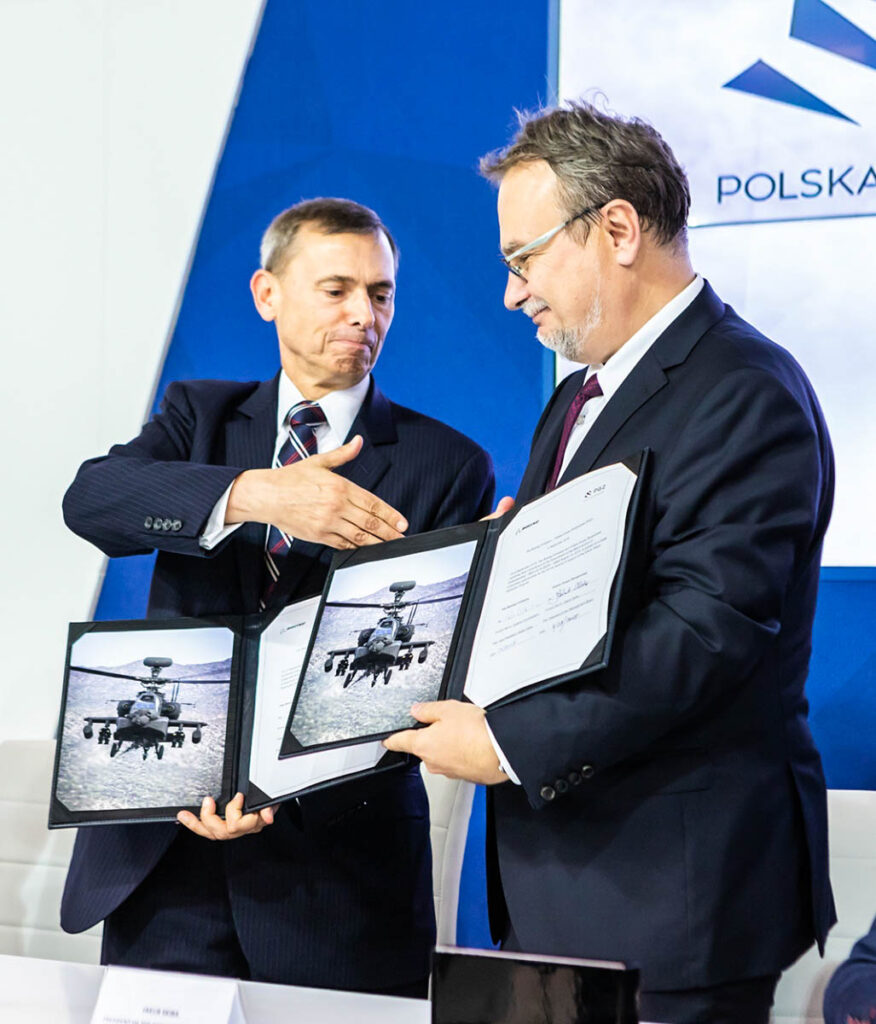
LS Mtron vehicle tracks for Polish Army
On the 5th of September, during the MSPO exhibition, an agreement between Polish company Pagacz & Synowie and Korean LS Mtron was signed.
The Korean manufacturer provides the Korean armed forces with tank tread products since 1975. The company experiences a dynamic growth and currently exports their products to over 20 countries. The agreement places Poland in their supply plans and allows for deliveries of continuous track parts for the Polish Armed Forces.
Parts are made to dimensional specifications of the original vehicle’s manufacturer but utilizing the modern technologies and materials. According to LS Mtron, this increases the usability of vehicles, especially the ones produced within the Warsaw Pact countries.
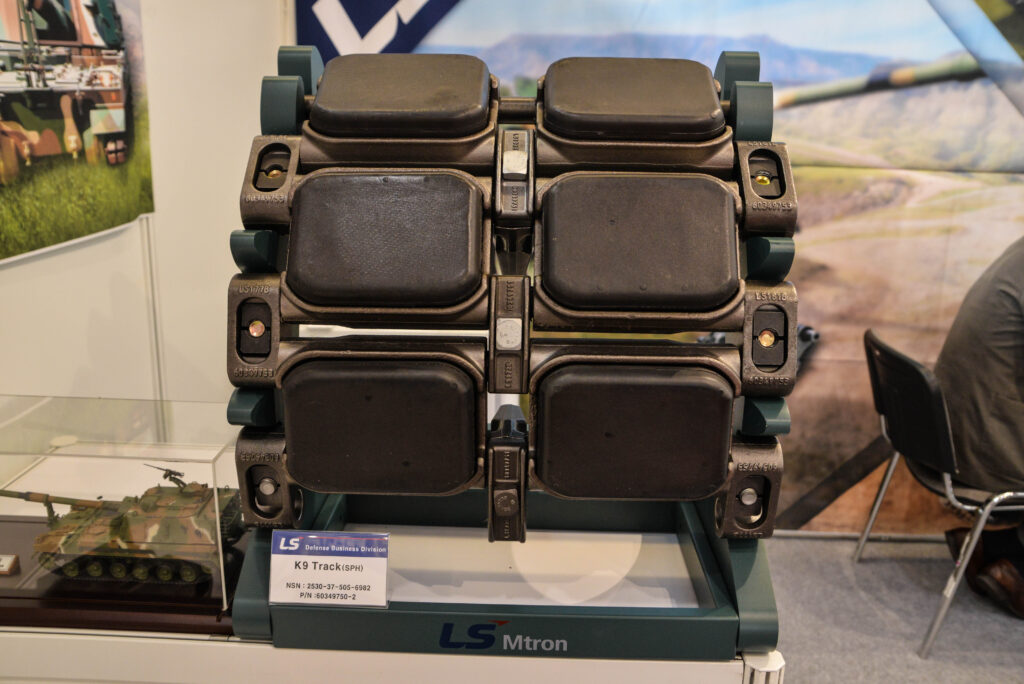
PCO and Elbit Systems cooperation
On the 6th of September, During the MSPO exhibition, PCO and Elbit Systems Electro-Optics Elop signed a cooperation agreement. In concerns research and development activities, manufacturing and servicing of the SPECTRO XR optoelectronic head and DIRCM aircraft protection system.
SPECTRO XR optoelectronic head is a multi-range, day/night optical system for long-range recon. The key element is a multispectral imaging system which combines multiple optical channels. This allows for improved efficiency without an increase in mass and size. SPECTRO XR was developed for use on various platforms such as helicopters, airplanes, sea vessels and land vehicles.
DIRCM (Directional Infrared Counter Measures) system is used for protection of aircraft against thermal guided air to air missiles. Elbit System Electro-Optics Elop Ltd. manufactures a range of such devices used in helicopters, transport, and civilian planes. The system works by jamming the sensors of the threatening missiles.
For efficient operation, DIRCM system requires advanced and dependable optoelectronic heads capable of rapid detection of threats in a full range of weather/light conditions.
Defenders awarded
During the last day of the MSPO International Defence Industry Exhibition, prizes for the best manufacturers of the armament and equipment were awarded. Ośrodek Badawczo-Rozwojowy Centrum Techniki Morskiej S.A. from Gdynia received an award from the President of the Republic of Poland for the SCOT shipborne combat management system. Minister of Defence prize went to Rosomak and WB Electronics companies for the Rosomak-based command vehicle. Special Best Armament Exporter award from the Minister of Entrepreneurship and Technology went to the Zaklady Chemiczne NITRO-CHEM from Bydgoszcz and to the WB Group. The award from CEO of Targi Kielce fell to the SPARTAQS company for the Prometheus – invisible dronoid with dispersion layers.
Defender awards were given to: Aviomet from Warsaw for the RSSA BAR atmosphere probing system; TELDAT from Bydgoszcz for C3IS Jasmin command support system; PCO from Warsaw for optoelectronic modernization package for the Leopard 2A4 tank; Instytut Technicznt Wojsk Lotniczych from Warsaw for the TURAWA-MATS IT system; ARPOL Narzedzia Profesjonalne for equipment of the container armament repair workshop; Wojskowa Akademia Techniczna, Instytut Techniczny Wojsk Lotniczych, MSP Marcin Szender joint venture for the TP-1 air target; WITU and Mesko joint venture for the M-21 Feniks HE missile; Wojskowa Akademia Techniczna, Akademia Marynarki Wojennej, PIT-RADWAR and Zakłady Mechaniczne Tarnów joint venture for the 35-mm naval armament system OSU-35; Lubawa for a light, shrapnel- and fire-proof, Szerszen suit; and Advanced Protection Systems for CTRL+SKY multisensor drone detection system.
The Border Guard commander prize went to the Flytronic from Gliwice for the FlyEye observation system. Police commander prize was given to Lubawa for the MARS vest. The best presentation-best booth award went to Inspektorat Sił Powietrznych Dowództwa Generalnego Rodzajów Sił Zbrojnych.
The Territorial Defence Force award was given to Maskpol for their Dromader carrying system.
The prize for the best training course went to Centrum Szkolenia Logistyki from Grudziądz for the specialist training of the JELCZ 442.32 maintenance crews.
4th Regionalna Baza Logistyczna from Wrocław received a prize for innovation in the modernization of Mercedes 250GD to ZWD-Wolf PL version.
This article was originally published on MILMAG 05-06/2018


